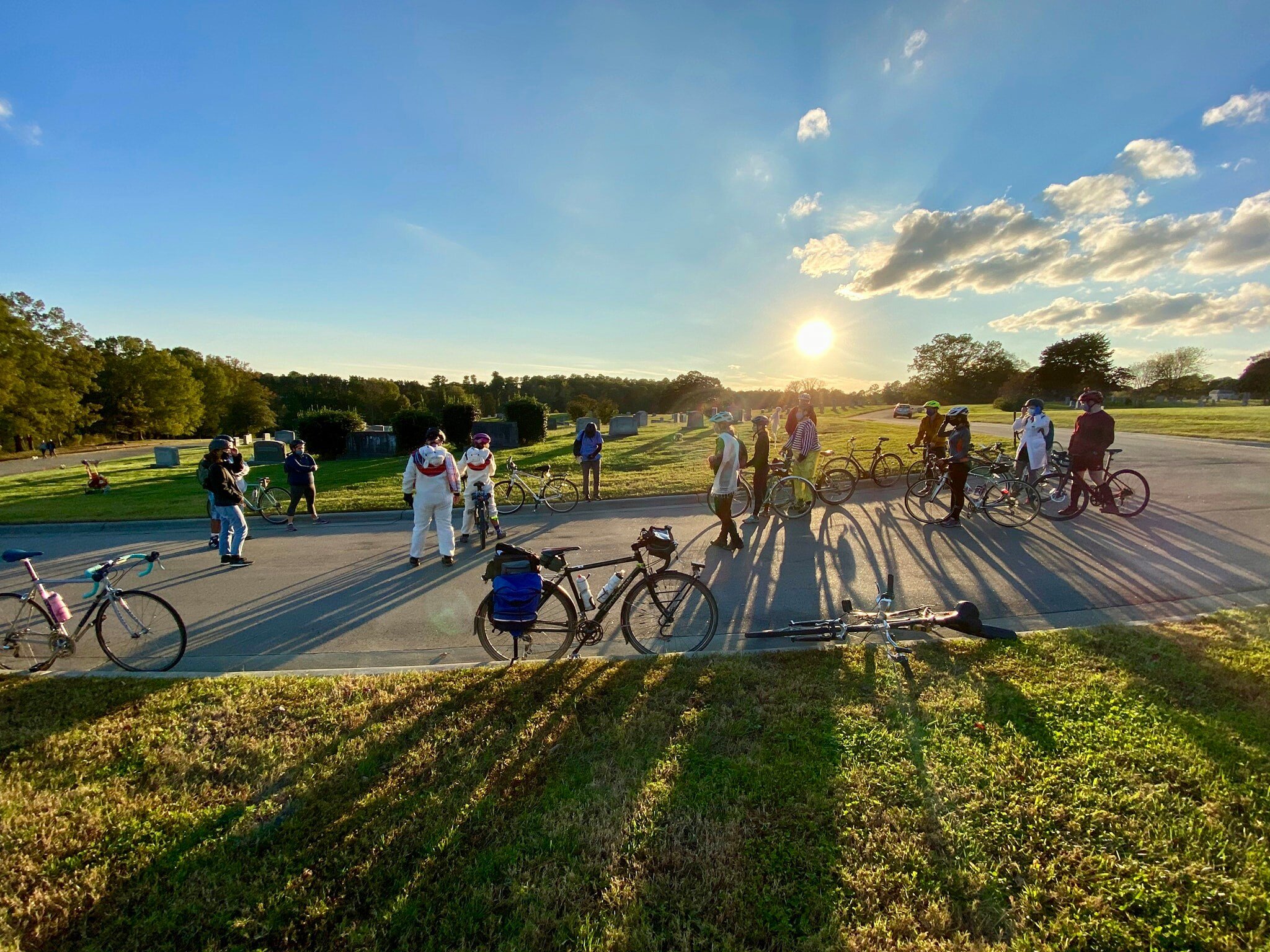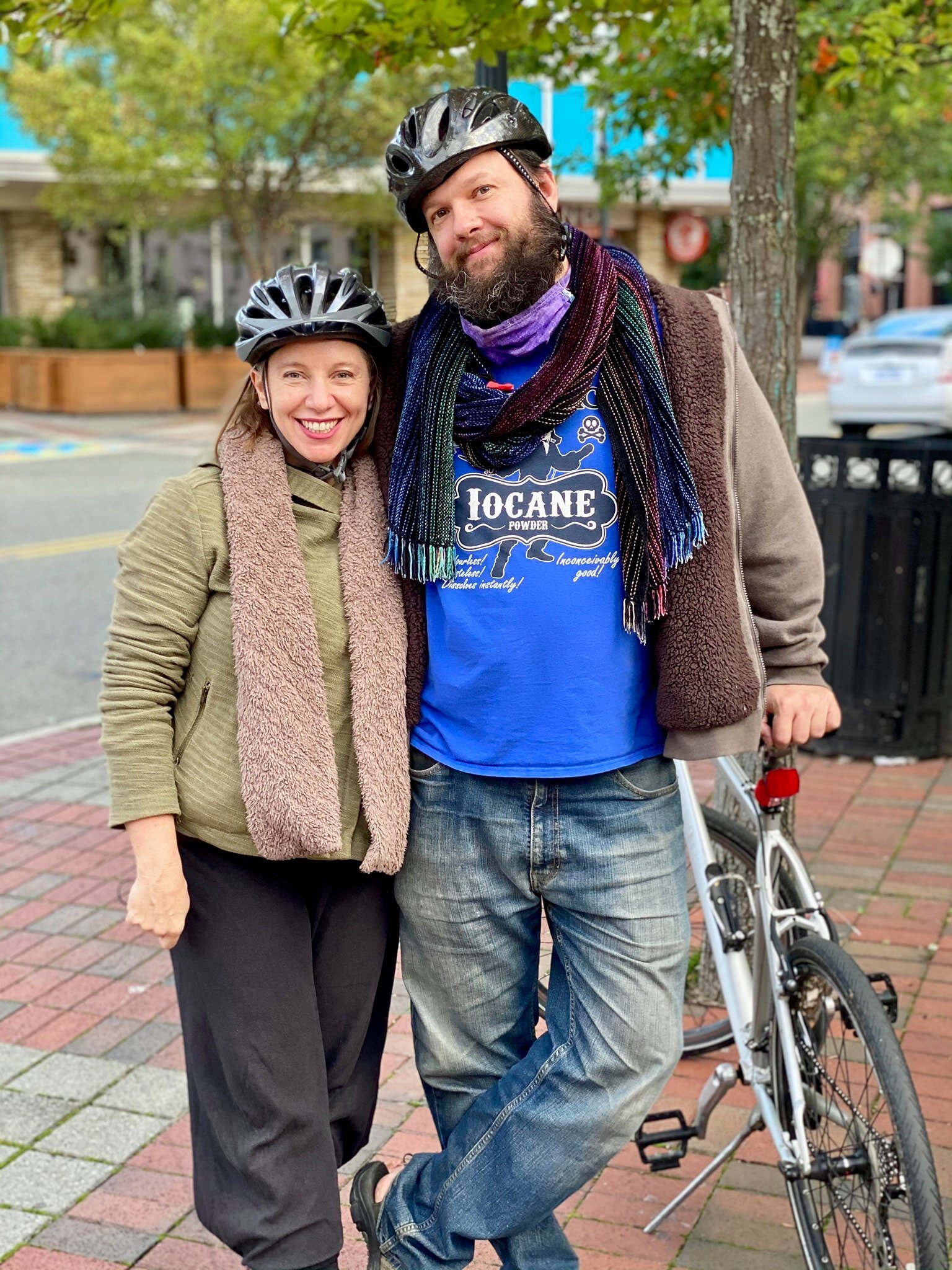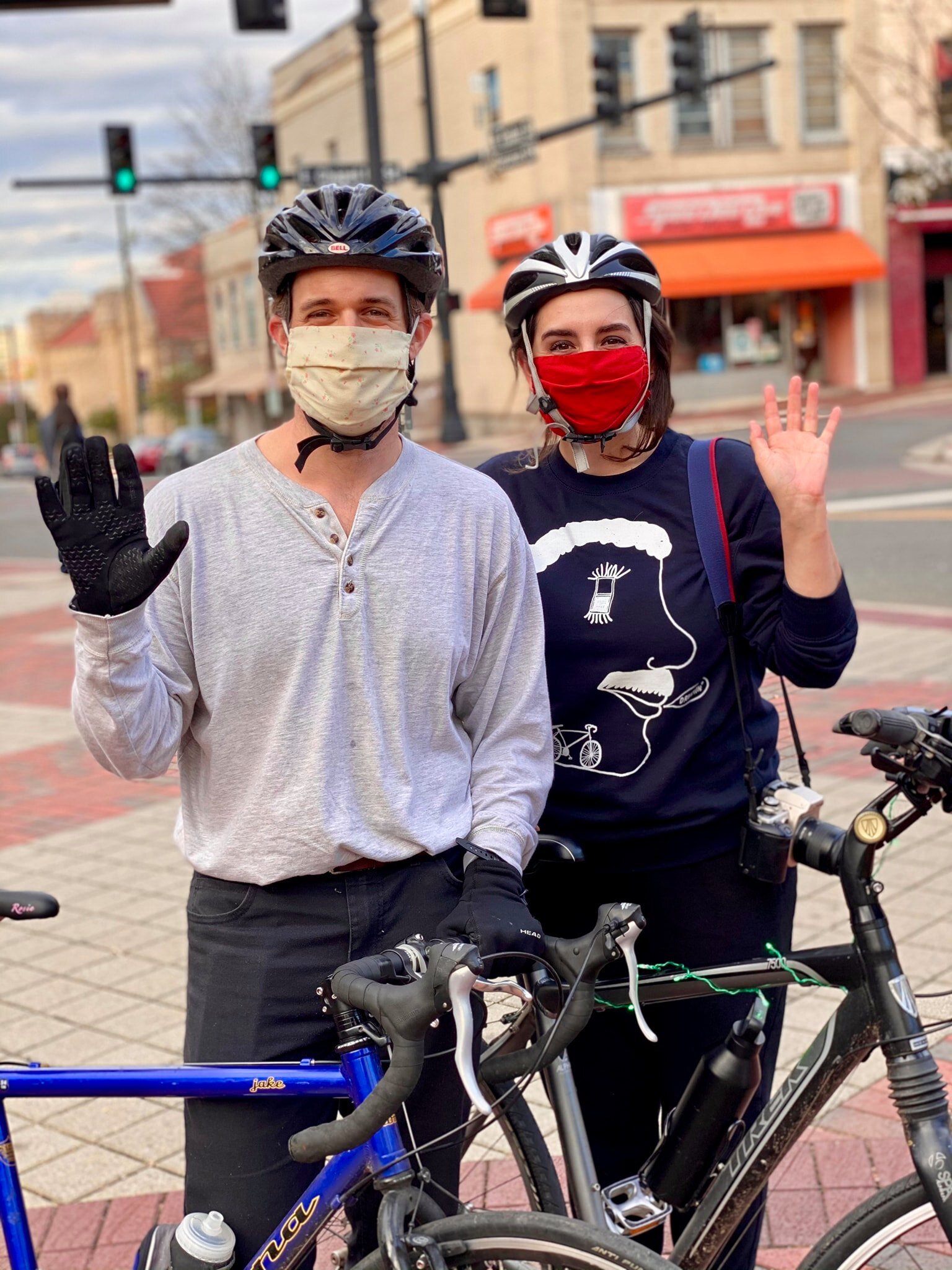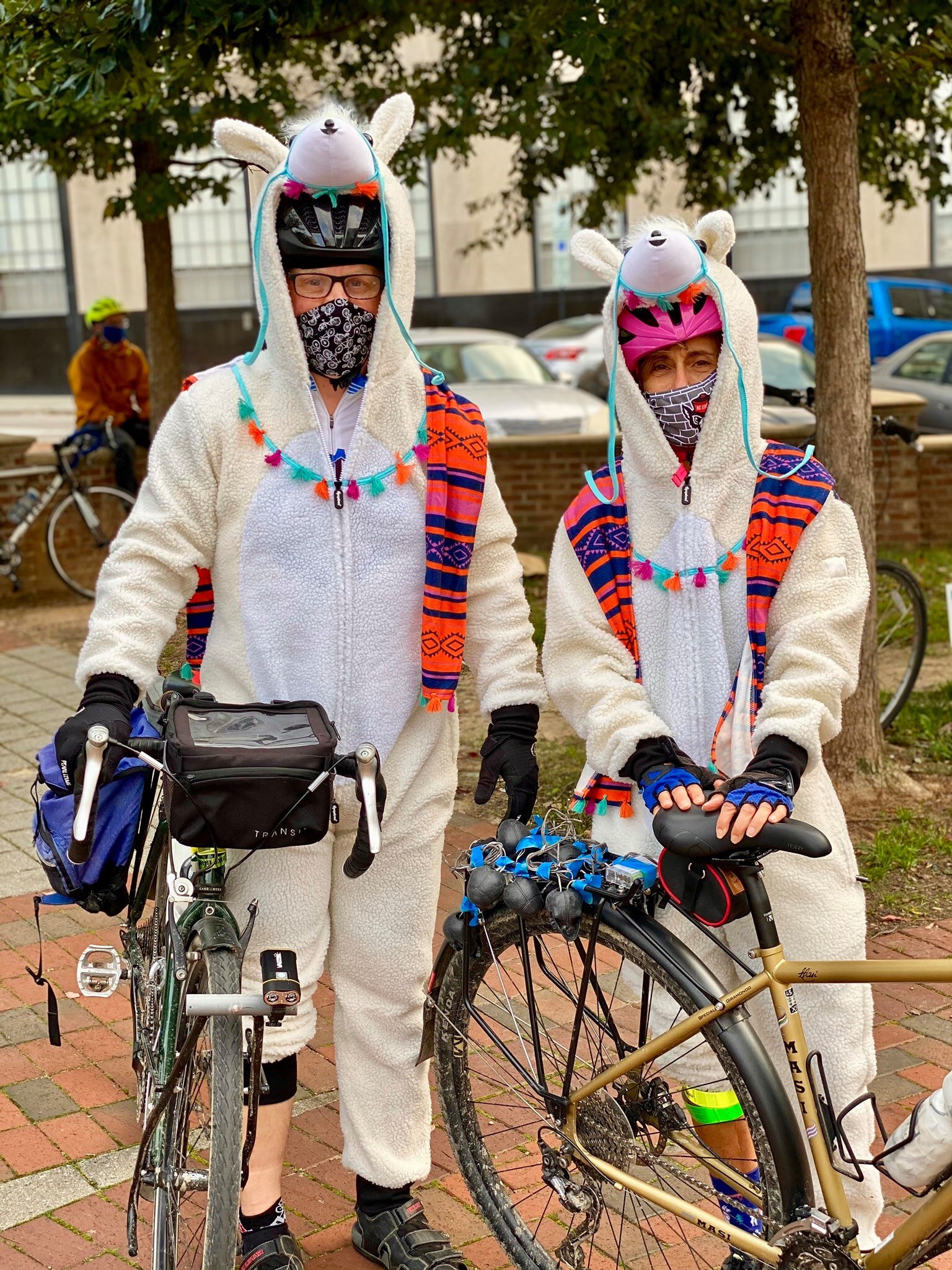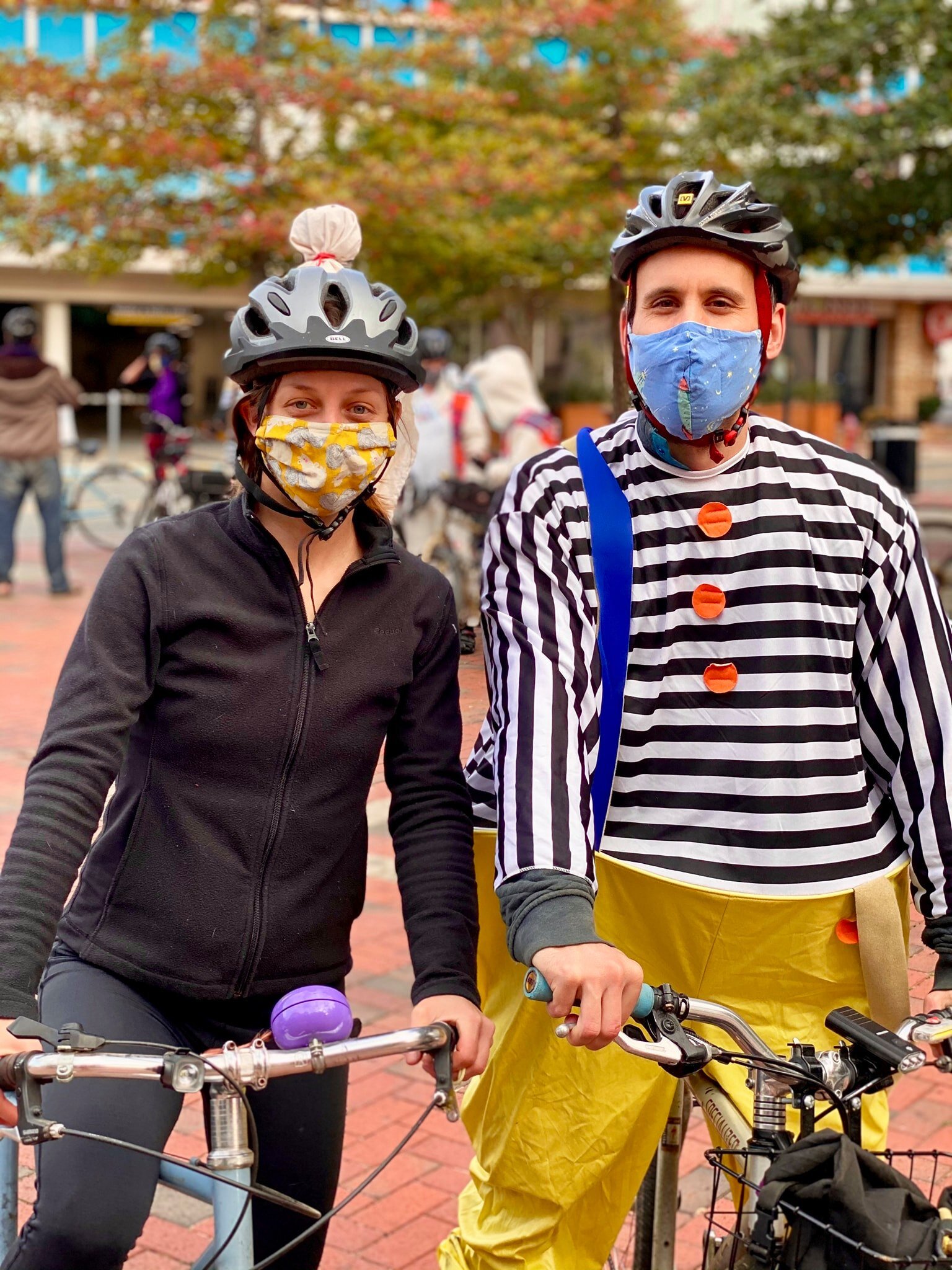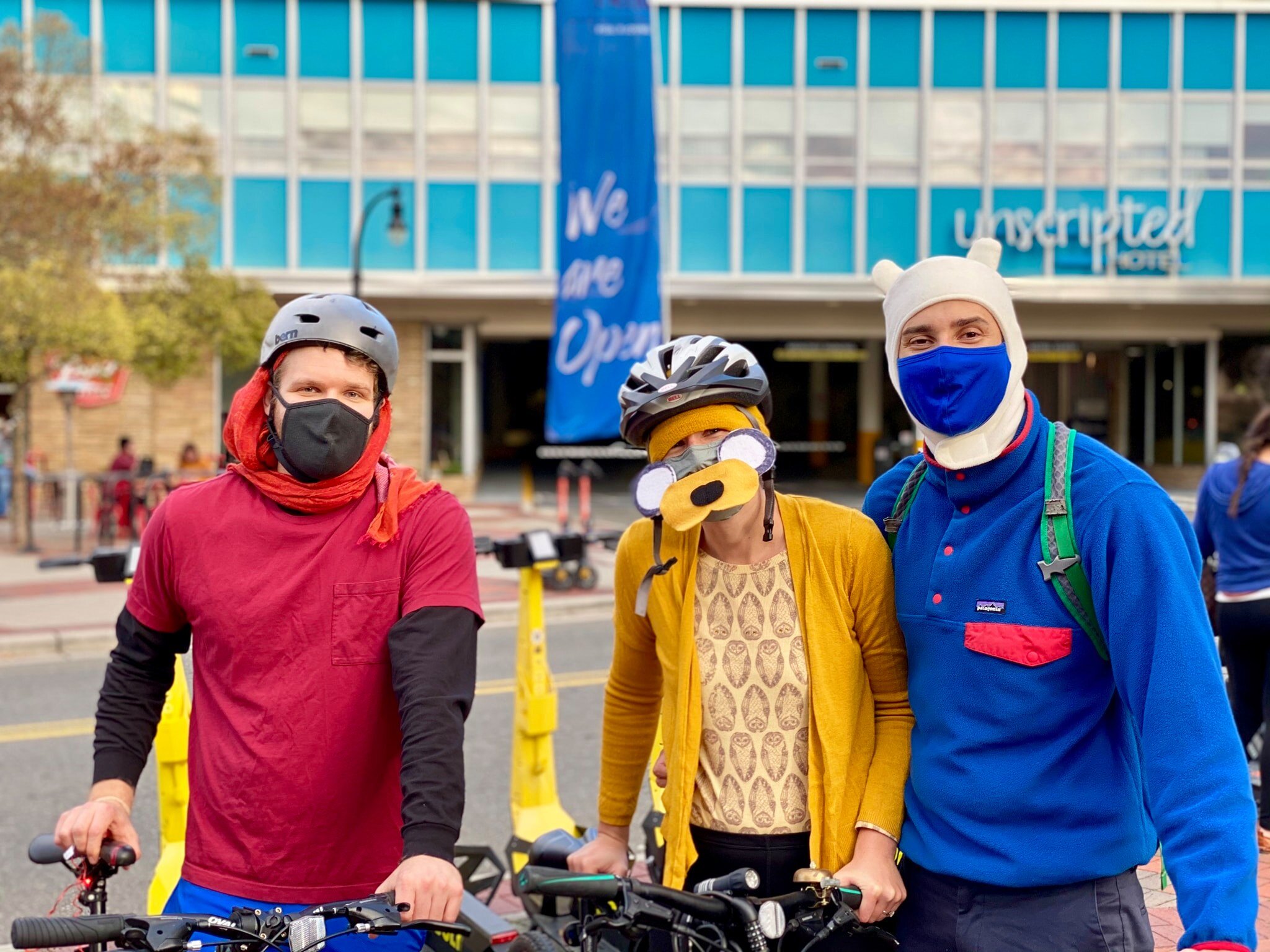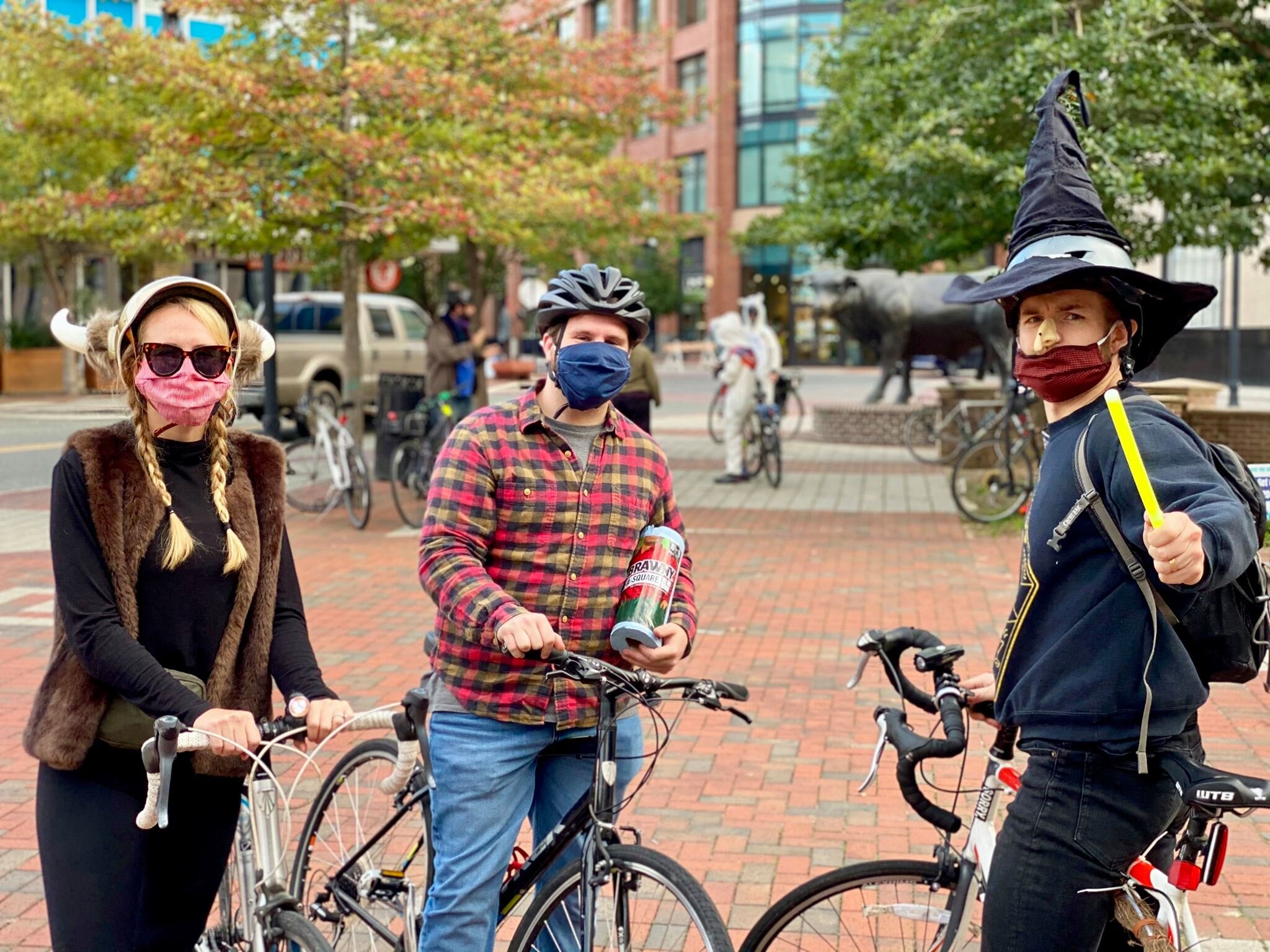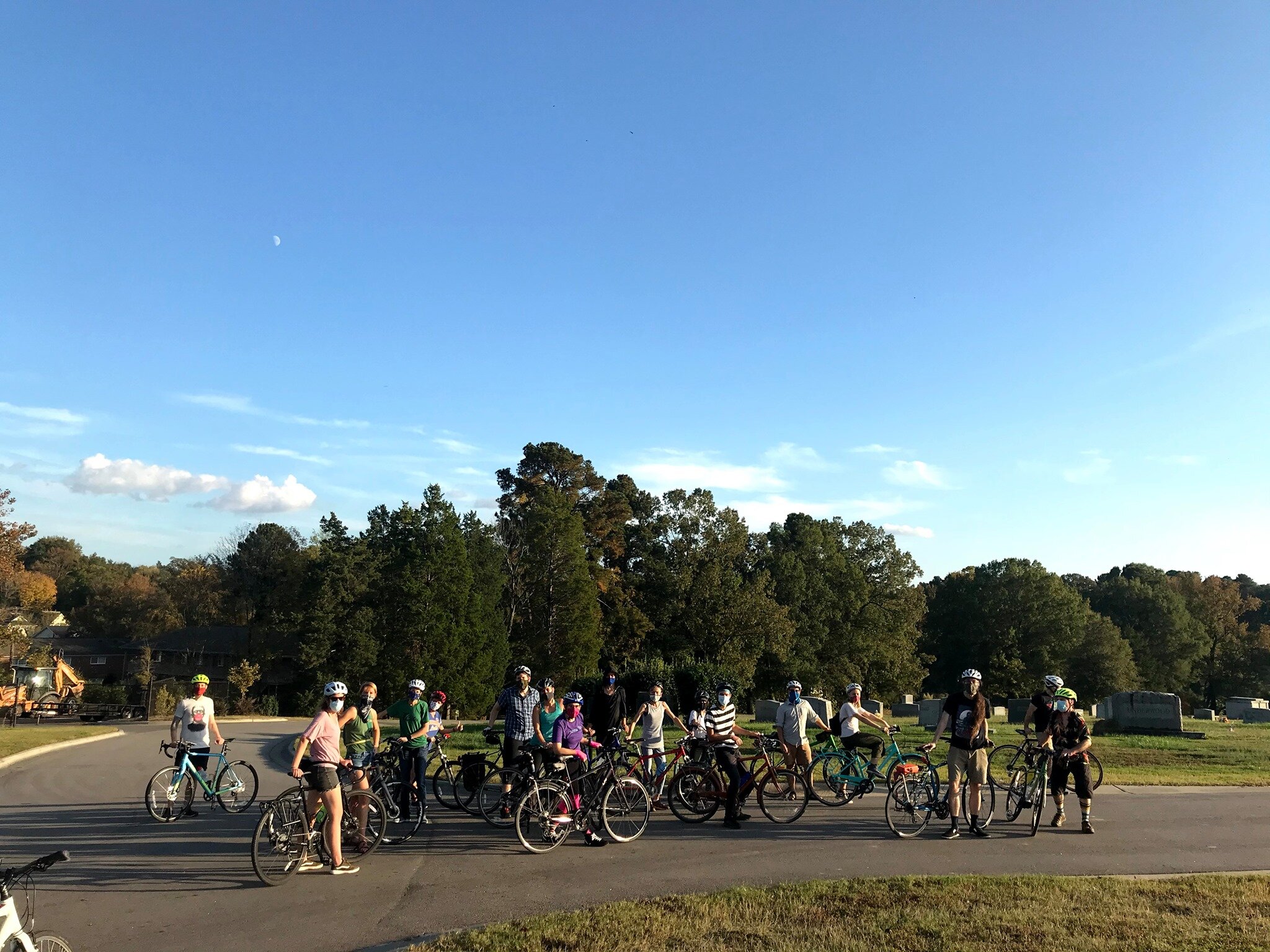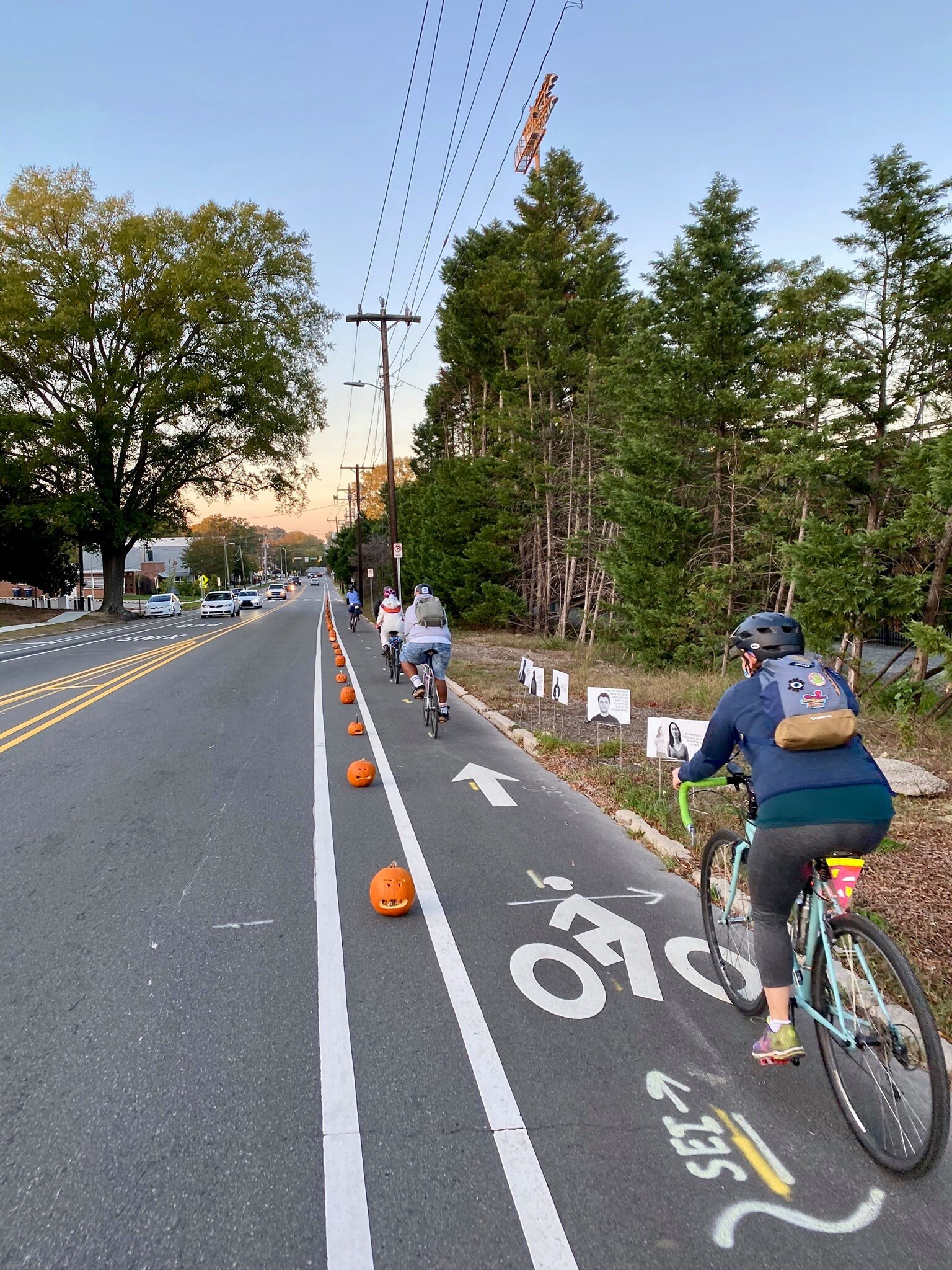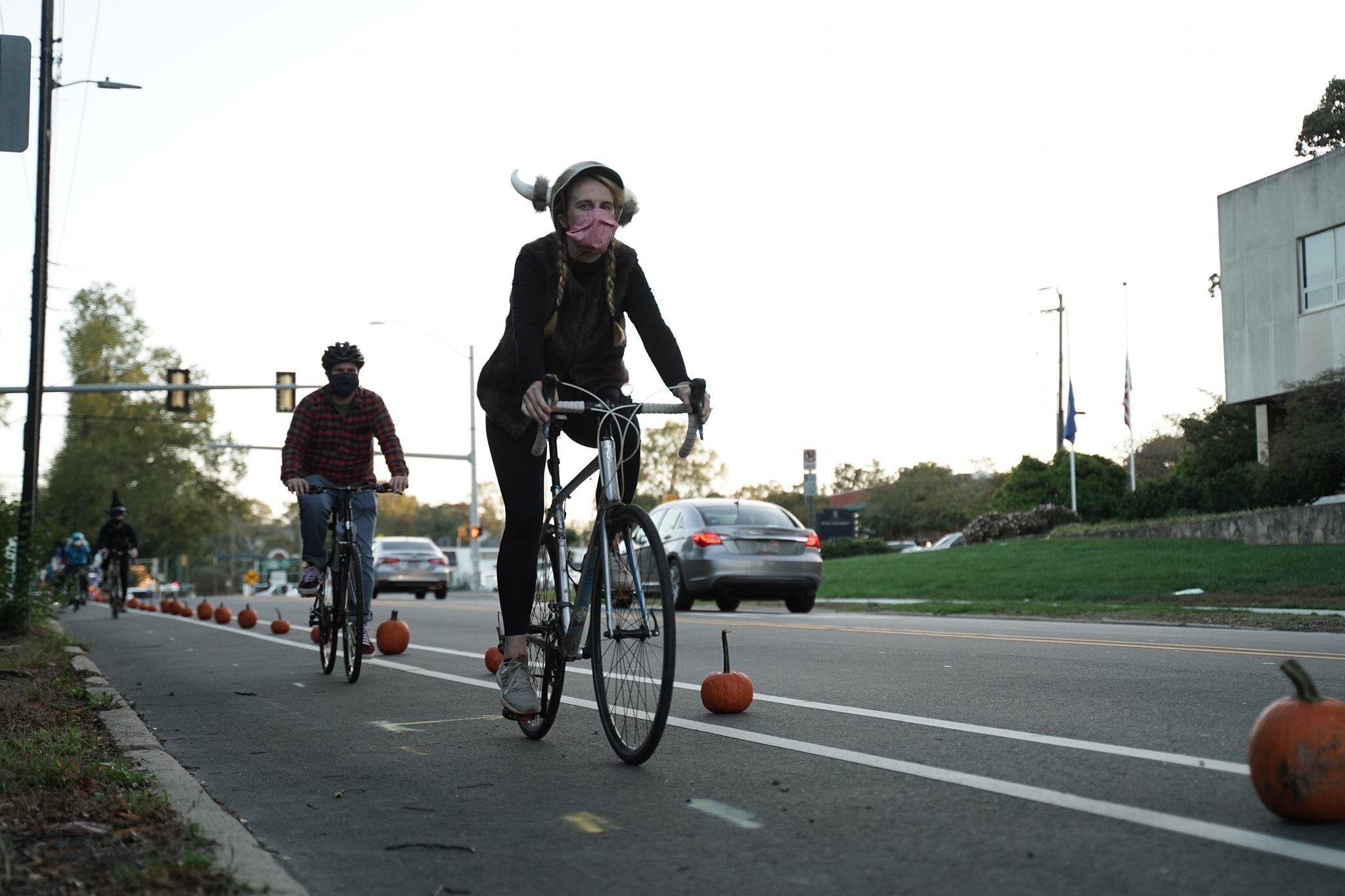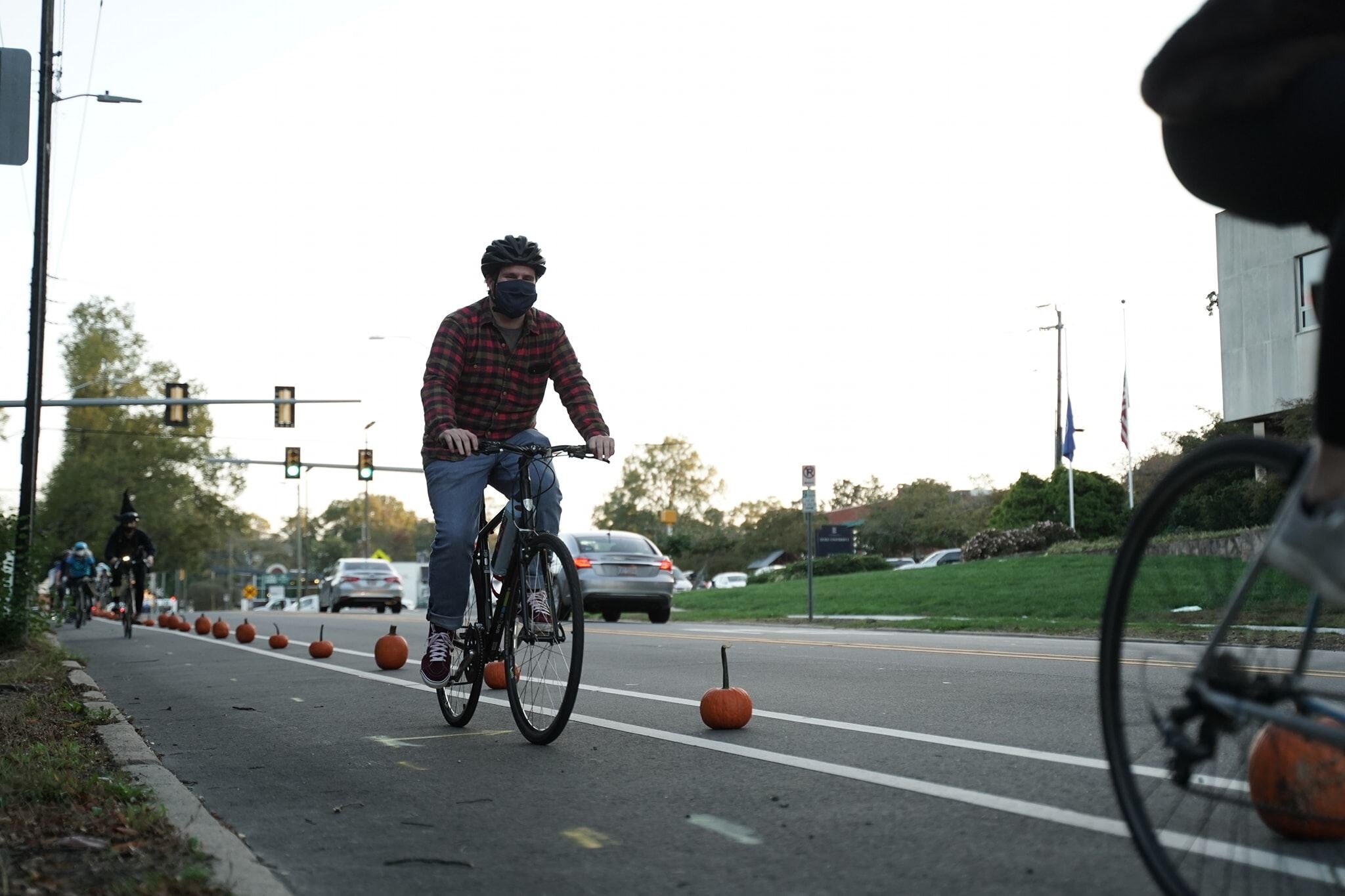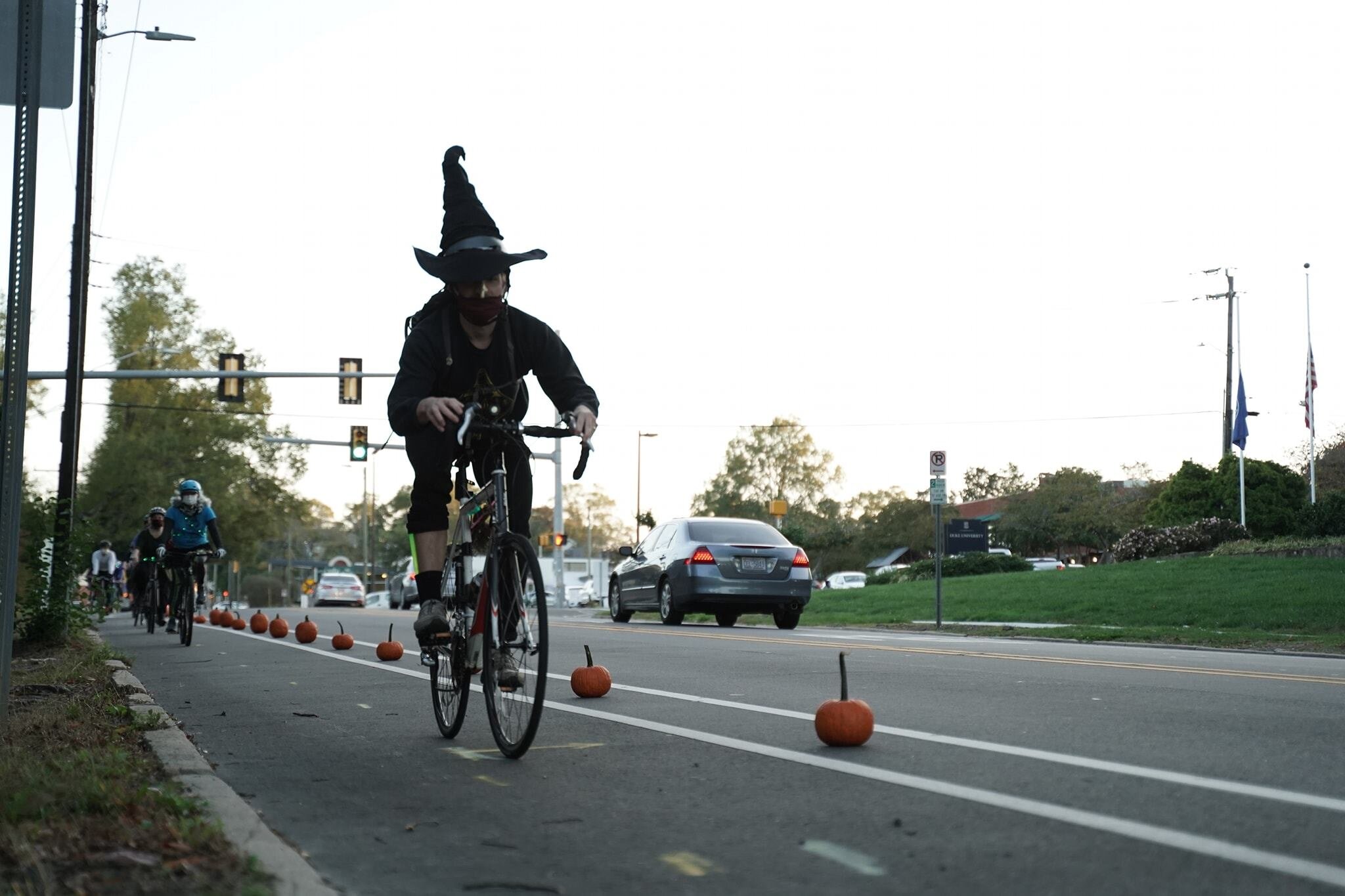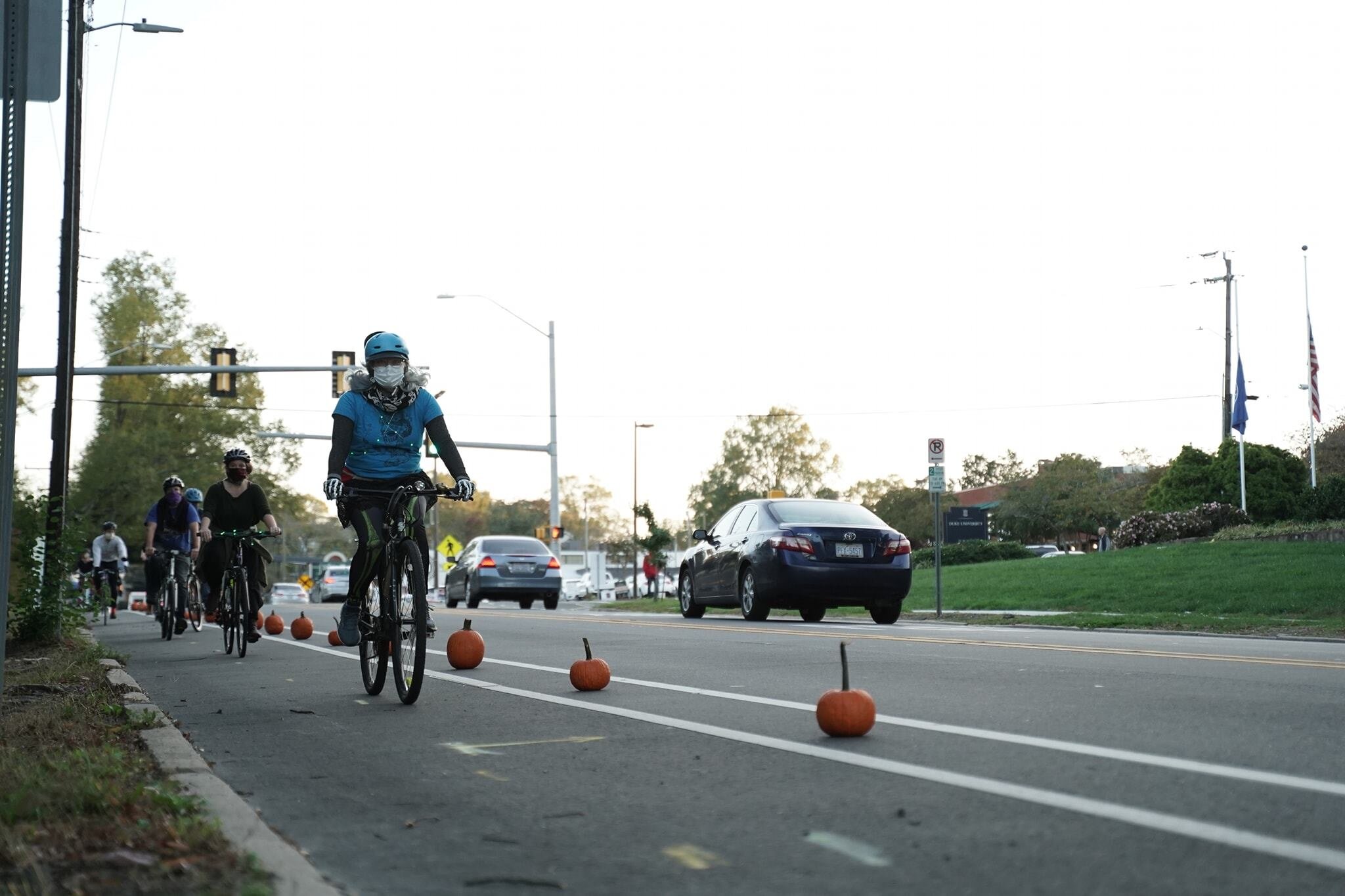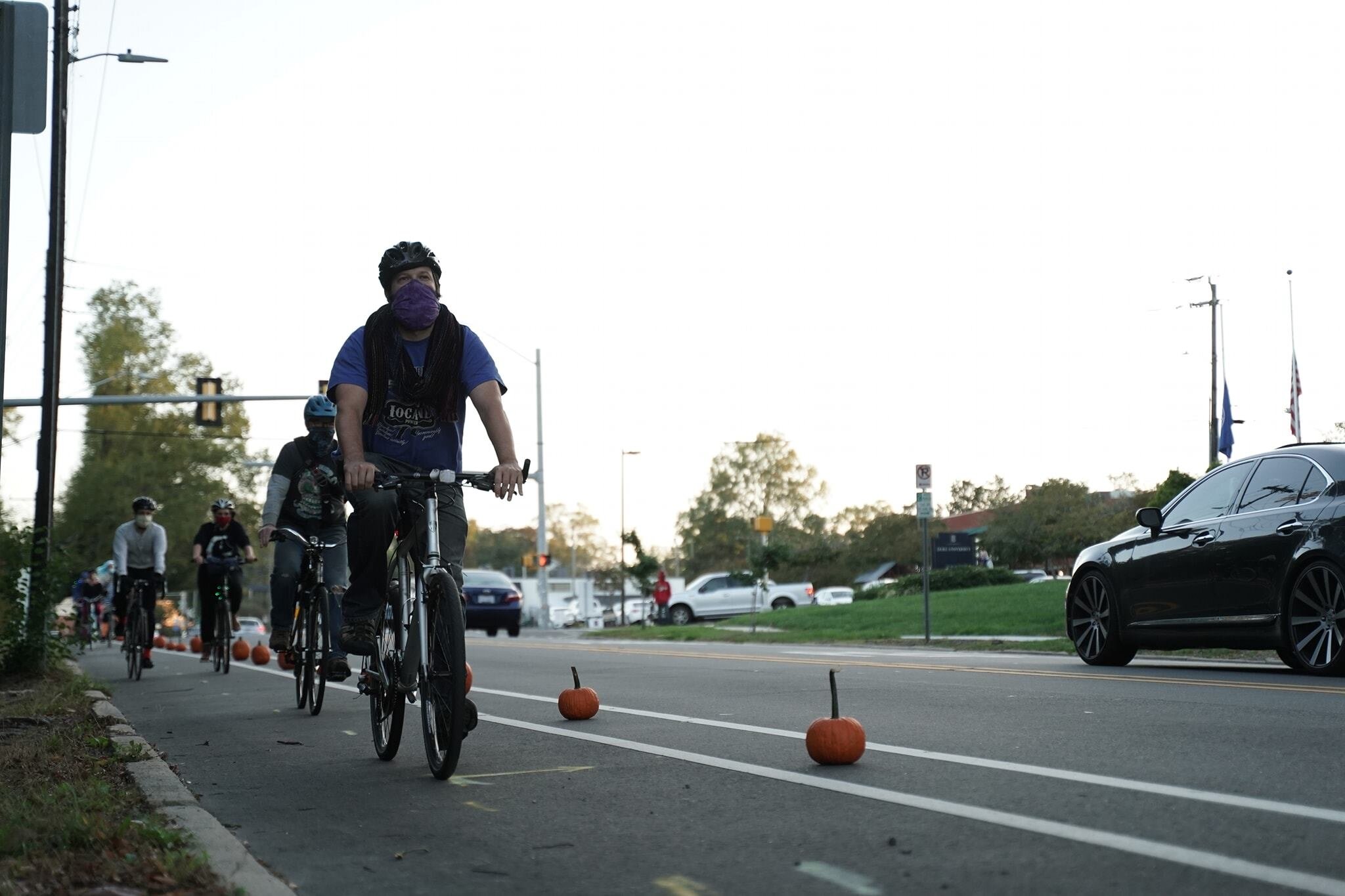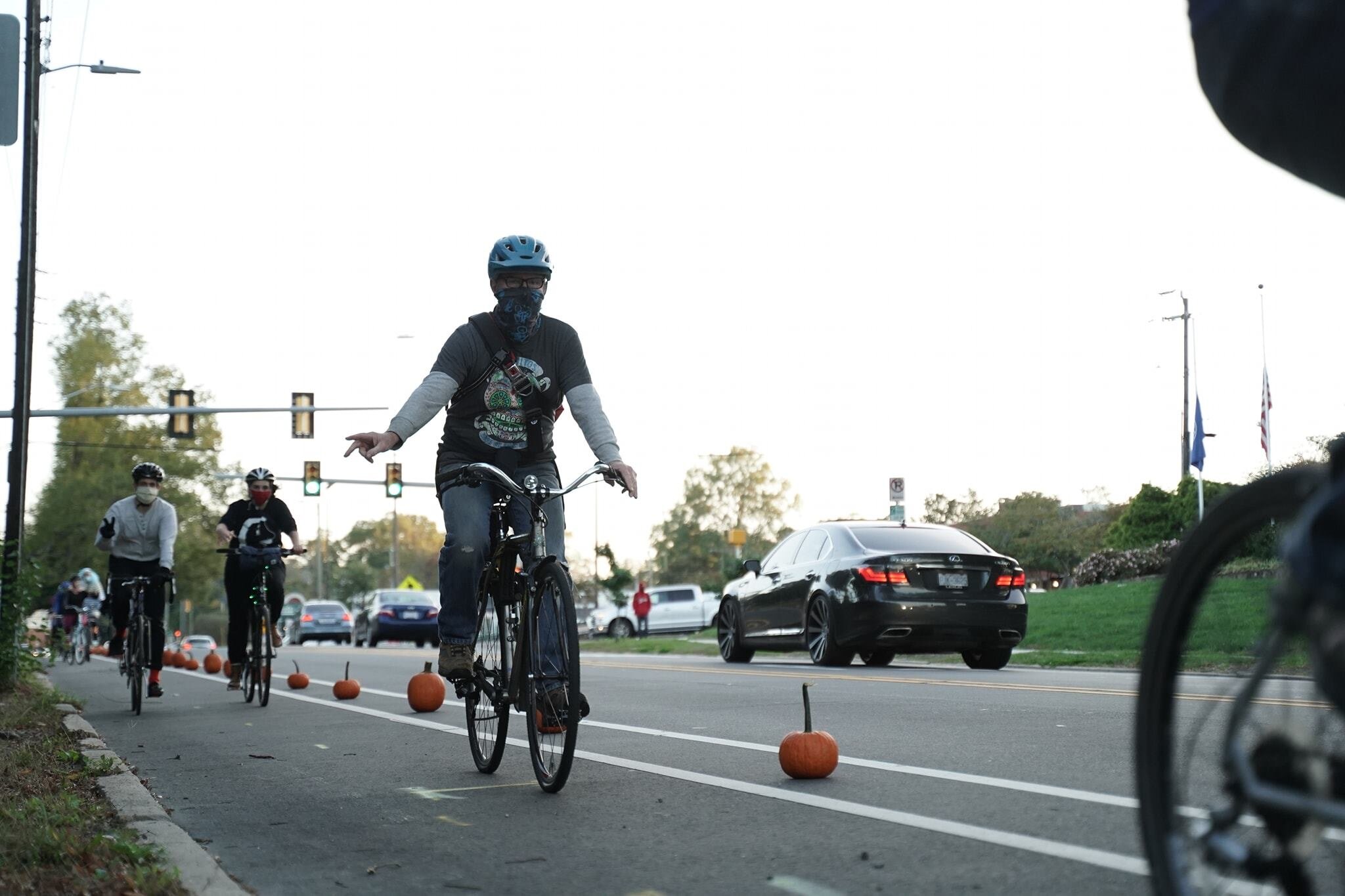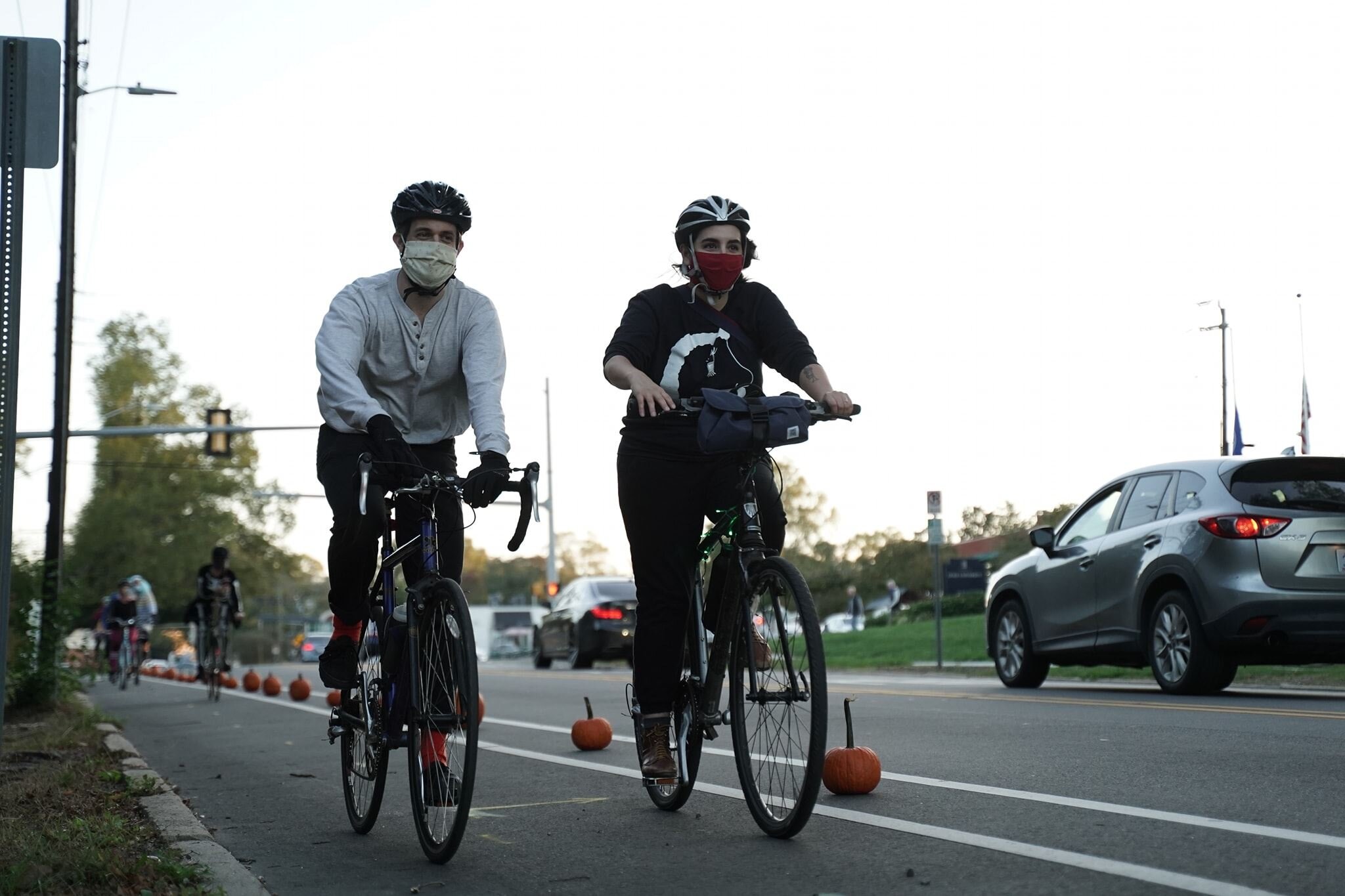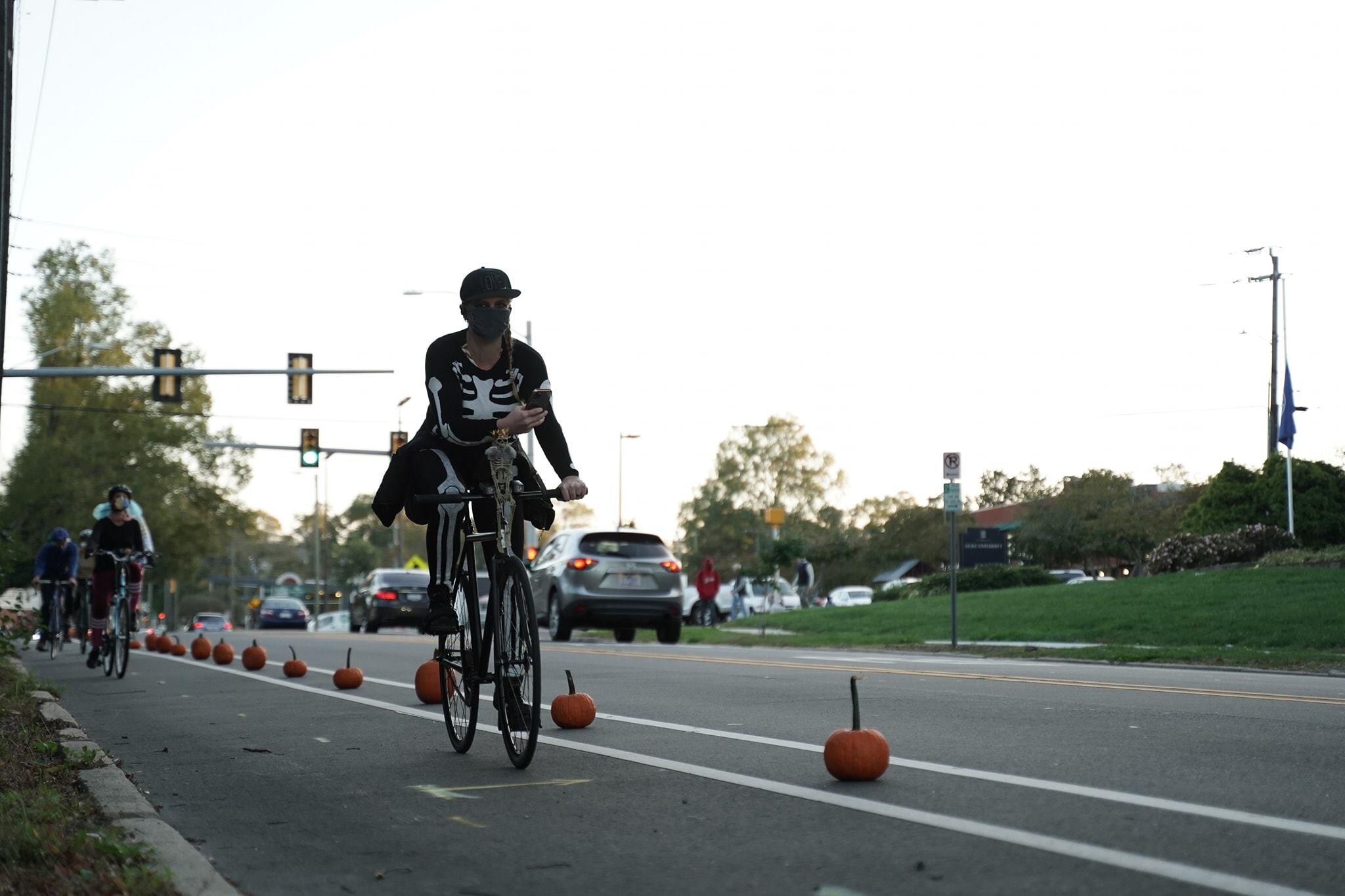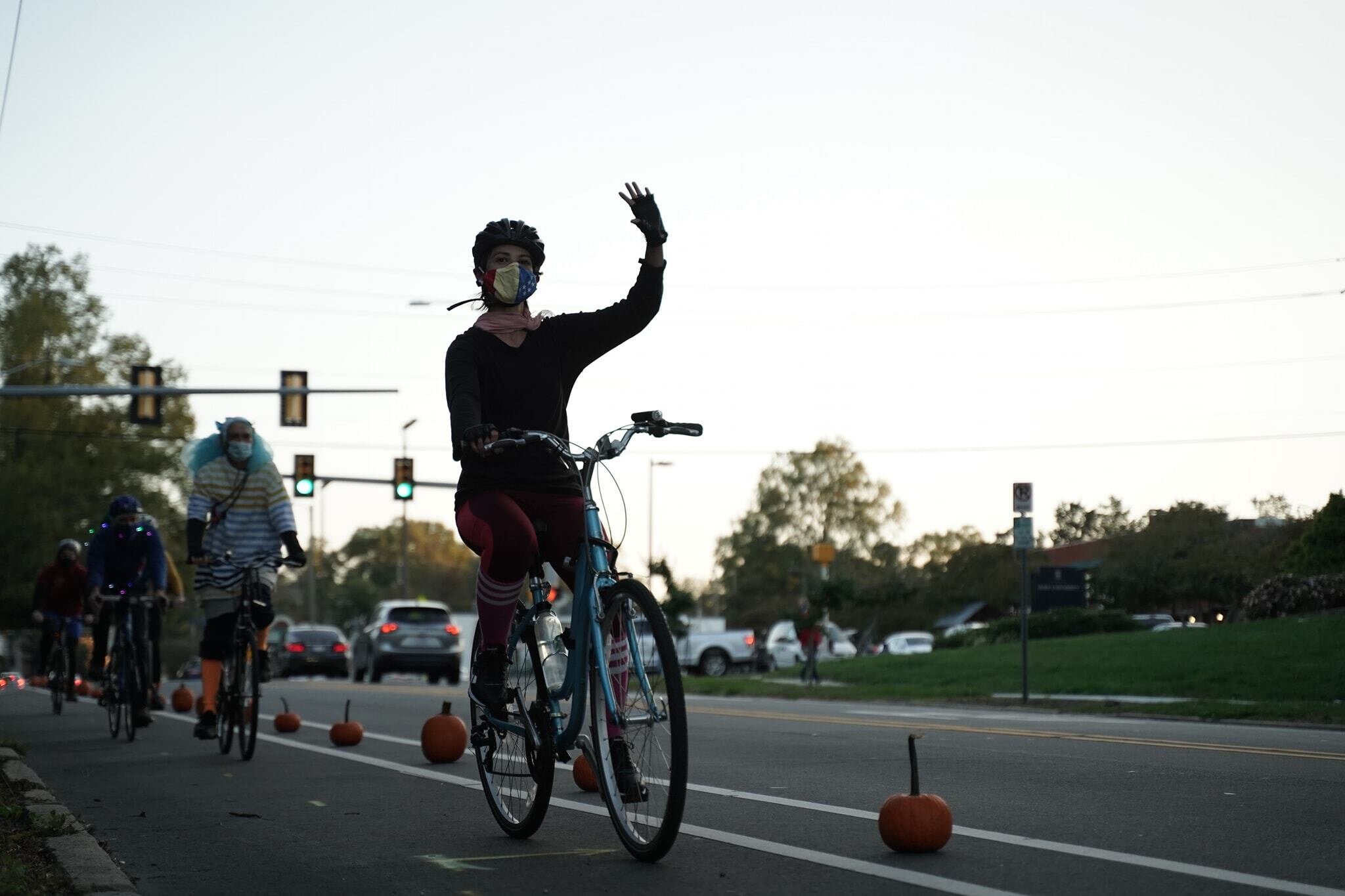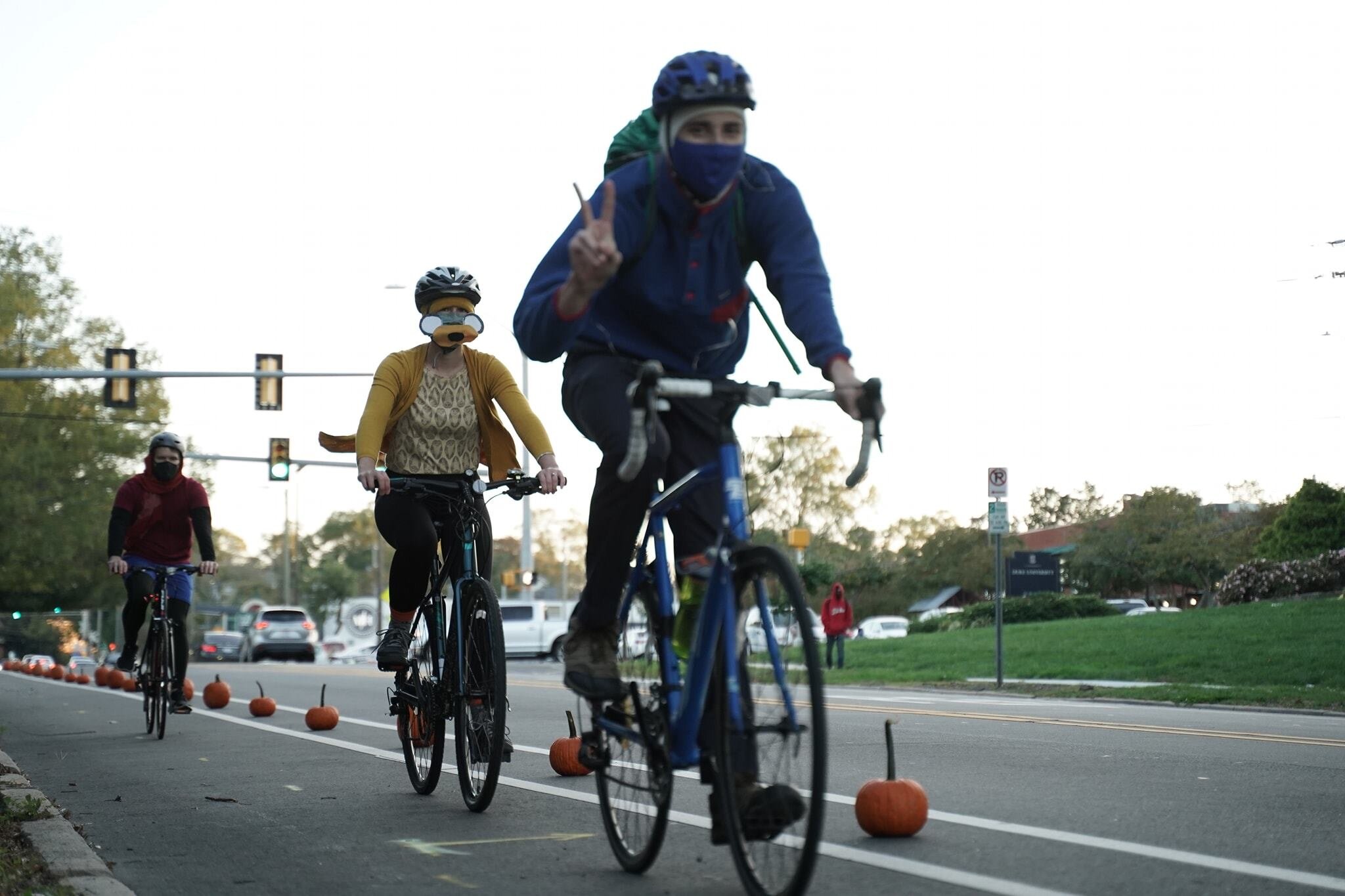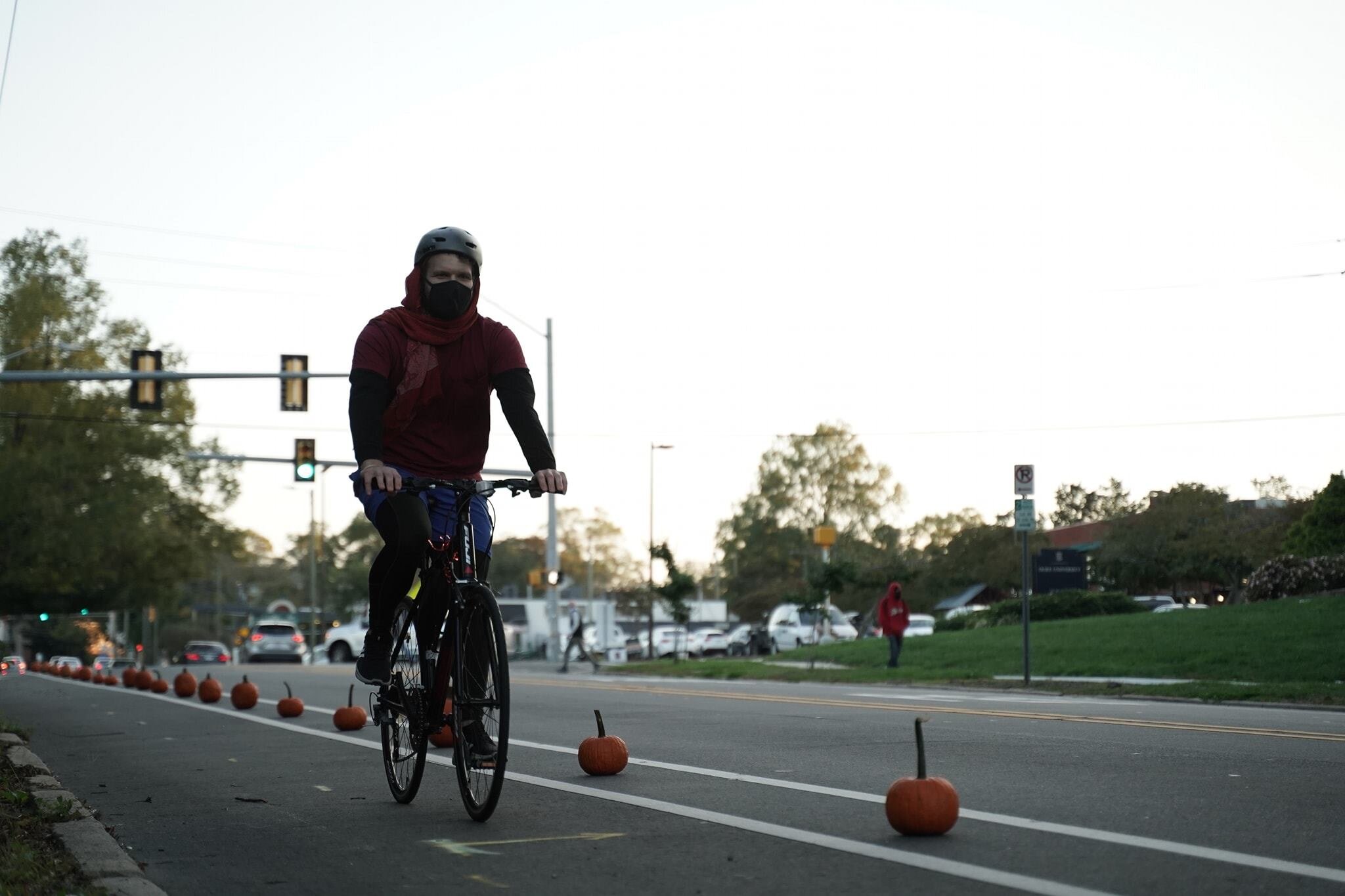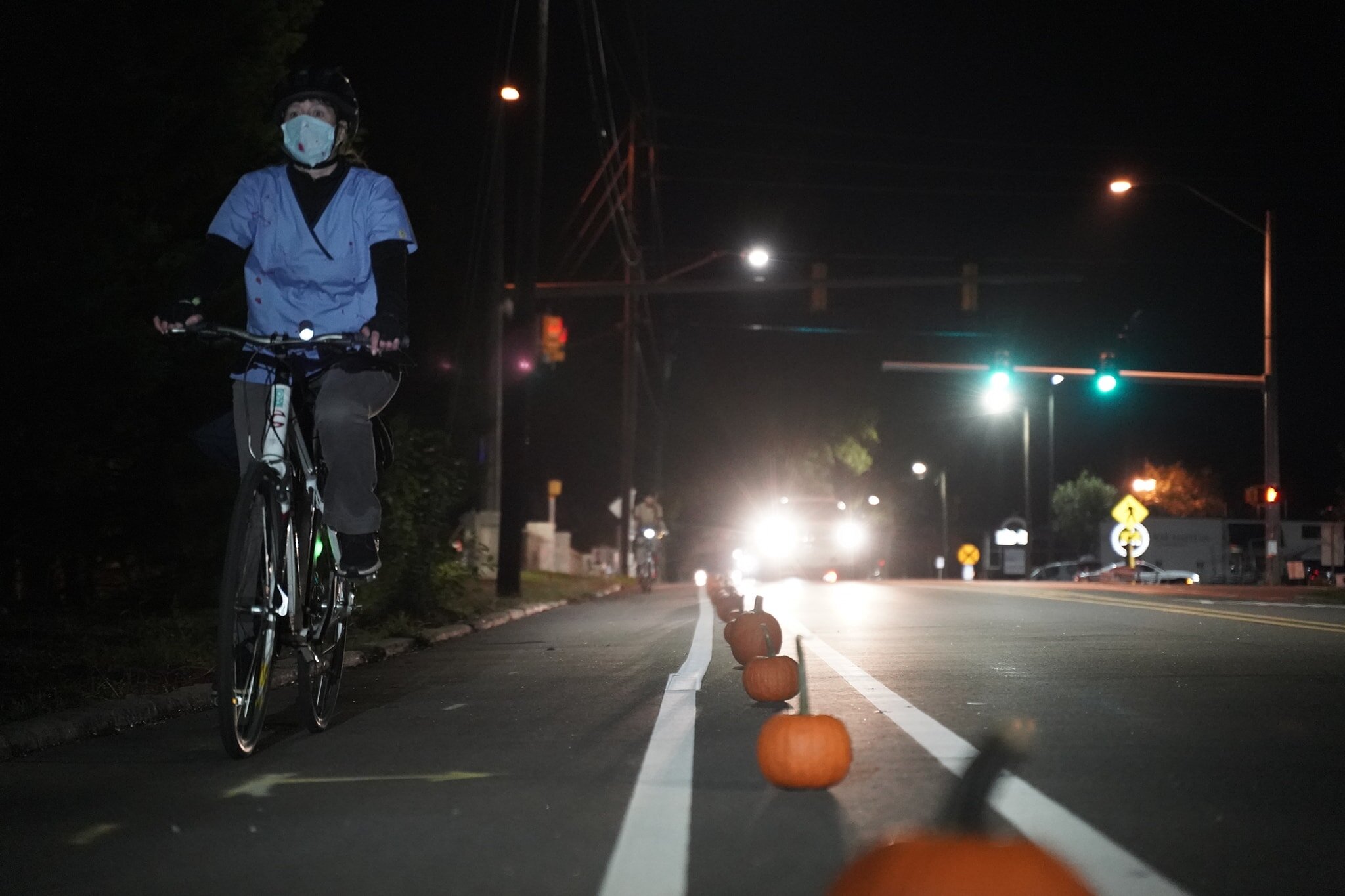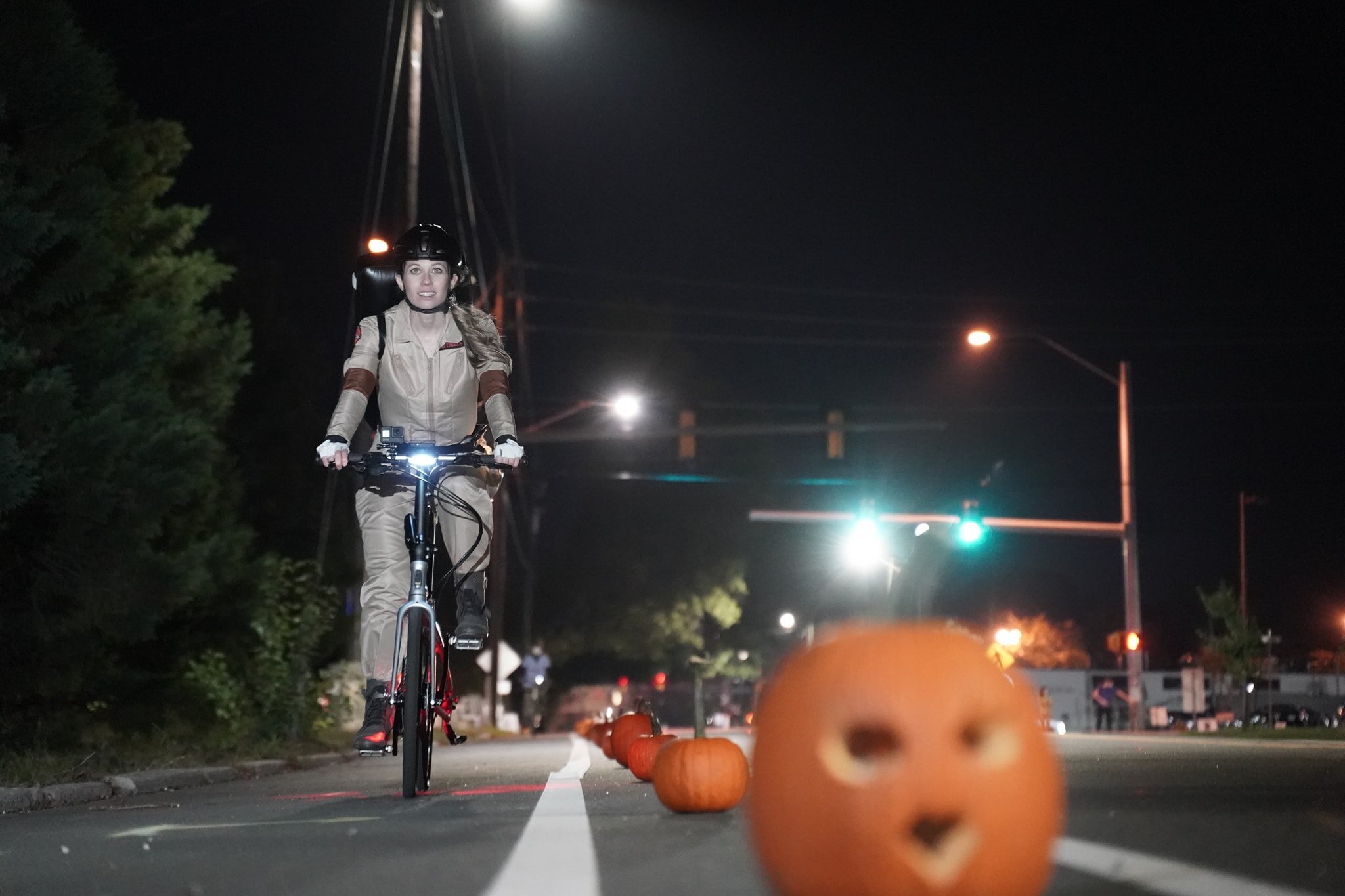Bike Durham starts off Bike Month with a community clean up at Ellerbee Creek Trail, and Charlie Reece, Durham City Council Member At-Large, makes an appearance.
Bike and Walk to School Day at Merrick-Moore Elementary
Fourth grade students walking around Merrick-Moore Elementary on Bike and Walk AT School Day
Tuesday morning I biked from Sherwood Park in east Durham to Merrick-Moore Elementary School at 2325 Cheek Road in east Durham where students were getting outside to walk around the school campus as part of national Walk and Bike to School Day.* It was good to see the kids outside, and they clearly enjoyed the break from the classroom, but this was certainly not walking and biking TO school. The reason this was a walk AT school event was clear when Dr. Vannessa Alford, principal at the school, asked the Kindergarten students why none of them walk to school. One of them called out “No sidewalks!”
Where the sidewalk ends at Merrick-Moore Elementary
Merrick-Moore Elementary is located on Cheek Road, a two-lane road with no shoulder and incomplete sidewalks. The school is a key institution in the Merrick-Moore neighborhood, a historically Black neighborhood that has a history of advocating for more walkable streets. “My community has lobbied for many years for safer streets. Sidewalks are needed more than ever,” Bonita Green, neighbor and President of Merrick-Moore Community Development Corporation told me in an email.
This isn’t just an issue at Merrick-Moore Elementary. Bike Durham’s Safe Routes to School Program Manager Jen McDuffie identified fifteen Durham Public Schools’ elementary schools that don't have safe streets for walking or biking around them. That’s more than half of the 29 DPS elementary schools. We know that parents aren’t going to allow their kids to walk or bike to school unless they feel that it’s safe. Investing in these connections to schools, and addressing other safety concerns that parents and children feel, have to be priorities before every child can experience the joy and independence of walking or biking to school.
Events like these are one way to raise awareness of the benefits that biking and walking to school can bring to the kids and also the parents. Two of our daughters attended E.K. Powe Elementary, right around the corner from our house, connected with sidewalks. When they were in fourth and fifth grades, they would walk independently to and from school. It was a great feeling of independence for them, and it freed my wife and me from having to race home from work to pick them up each day.
These events are also an opportunity to identify the obstacles, like poor or missing infrastructure. This event at Merrick-Moore was organized by Stephen Mullaney, an accelerated teacher at the school, and supported by Bike Durham’s Safe Routes to School Program Manager Jen McDuffie. It was attended by School Board member Natalie Beyer, City Council members Jillian Johnson and Pierce Freelon, and Durham Transportation department staff Bill Judge and Dale McKeel. Along with Dr. Alford, we had good conversations about the need to connect Merrick-Moore and the surrounding neighborhoods with sidewalks, and other strategies to advance the outdoor education at the school.
As I left the school, I was thankful for a lot of things: that Bike Durham has this new partnership with the City and DPS to provide Safe Routes to School programming; that there are teachers like Stephen Mullaney and principals like Dr. Alford who are leaders in getting kids outdoors and active; that we have elected leadership that supports investing in sidewalks and bicycle facilities; and that all the pick up trucks were giving me wide berth as they passed me along Cheek Road.
*May 5th is actually the national Walk and Bike to School Day. However, there wasn’t any biking or walking to public schools in Durham today because Wednesdays are Wellness Days for Durham Public Schools, meaning that students don’t have class in-person or remote.
Challenges to Equitable Transit - A Durham Documentary
“People use transportation just like they use their own car. And if their car wasn’t reliable, let’s say, their car could only crank up every hour, they would be so frustrated! So they have to look at it like that, like this is our car and we need it to be more reliable.”
- Holly McCoy, Transit Rider
In “Challenges to Equitable Transit - A Durham Documentary”, we see and hear the voices of transit riders and transit workers as they describe the main challenges they face using the bus in Durham. These challenges echo ones we’ve heard from other riders, transit workers, and people who live in low-wealth communities of color and that were captured in the first round of public engagement for the Durham Transit Plan update.
Riders are demanding:
More frequent service
More reliable service
More direct service with shorter travel times to jobs and other destinations in Durham and the region
Safer walks to bus stops
Accessible and comfortable bus stops
Expanded paratransit and other curb-to-curb service
A core strategy of the Transit Equity Campaign is to identify and communicate the transportation needs of current transit riders and low-wealth communities of color in Durham to decision-makers and the general public. The Transit Equity Campaign has relayed many of the needs we have heard to those in charge of updating the Durham Transit Plan, but there is no substitute to those officials hearing these needs directly from the riders in their own voices. This is particularly critical as already limited opportunities to listen to riders, such as bi-monthly public meetings at Durham Station, have been discontinued during the pandemic.
The Transit Equity Campaign commissioned two local videographers, John Laww and Saleem Reshamwala, to produce videos that describe the benefits and challenges of Durham’s current transit system through transit rider and worker interviews and showing the rider experience directly.
In addition to “Challenges to Equitable Transit - A Durham Documentary,” we created three shorter video vignettes to capture individual stories and topics. The first of these, “Supporting Transit for Persons With Disabilities,” spotlights Marie Hill Faison, a paratransit operator for GoDurham ACCESS and a Transit Equity Campaign partner. Paratransit is a federally mandated curb-to-curb service for persons with disabilities and is complemented by a county-wide system that fills in gaps in the fixed-route bus system in Durham. The Durham Transit Plan should reduce wait times and expand service levels on local and regional bus and paratransit services to improve the lives of those who cannot drive due to a disability. This would also increase transportation options for people who live or work in parts of Durham County where bus service does not run.
Transit service is only useful if people can safely get to and from bus stops and feel safe and comfortable at the stops themselves. The second vignette, “Walking To and Waiting At the Bus Stop,” focuses on the lack of sidewalks and safe street crossings for people walking to and from bus stops and the poor condition of many of the bus stops in Durham. These issues were identified by every rider we interviewed for these videos. The Durham Transit Plan should ensure that bus stops in Durham have safe sidewalk connections and consistent, dignified waiting conditions at the stop.
The final vignette focuses on a transit journey George A. Long, a longtime GoDurham rider, takes to accompany his friend, Lisa Raiford, to get her COVID-19 vaccination. What could be a better demonstration of how essential transit is in Durham?! George has benefited from a doubling of frequency on the route that serves his apartment, GoDurham Route 12, and newer buses, both of which have been funded through the Durham Transit Plan. The Durham Transit Plan should ensure more frequent service and better buses are provided to more people in Durham to improve access to jobs and services, particularly for low-wealth communities of color.
If you support these priorities, please click the link below to sign on to the Transit Equity Campaign.
Bike Durham's Letter to the City on Cornwallis Road Project
After a long delay, the City is going forward with plans to reconfigure Cornwallis Road from Chapel Hill Road to South Roxboro Street, to be completed in 2025. While we commend the City for improving bicycle and pedestrian facilities, design standards have evolved in the 20 years that have gone by since the plan was initially conceived.
Before the Thanksgiving break, Bike Durham sent a letter to City staff with our feedback on the project. The letter is reproduced in full below. Here are our key recommendations:
Separated facilities for those walking, biking, scooting, or rolling must be included in every street project in Durham, including Cornwallis Road.
A planning-level estimate of the additional cost and time necessary to complete this project according to best practices should be provided. Without such an estimate, the public, staff, and elected officials cannot adequately weigh whether maintaining the current design is a worthwhile tradeoff.
Projects that consider pedestrian, bicycle, or transit elements and/or are initiated by the Durham Transportation Department should be developed through at least 30% engineering by Transportation staff so that the intention and integrity of the projects can be carried through a more advanced design phase.
An analysis should be done to determine the causes that lead projects like Cornwallis Road to take over 20 years from conception to completion and recommend corrective actions for future projects.
More flexibility needs to be built into the process to allow for changes that reflect new best practices, particularly if projects are going to take decades to complete.
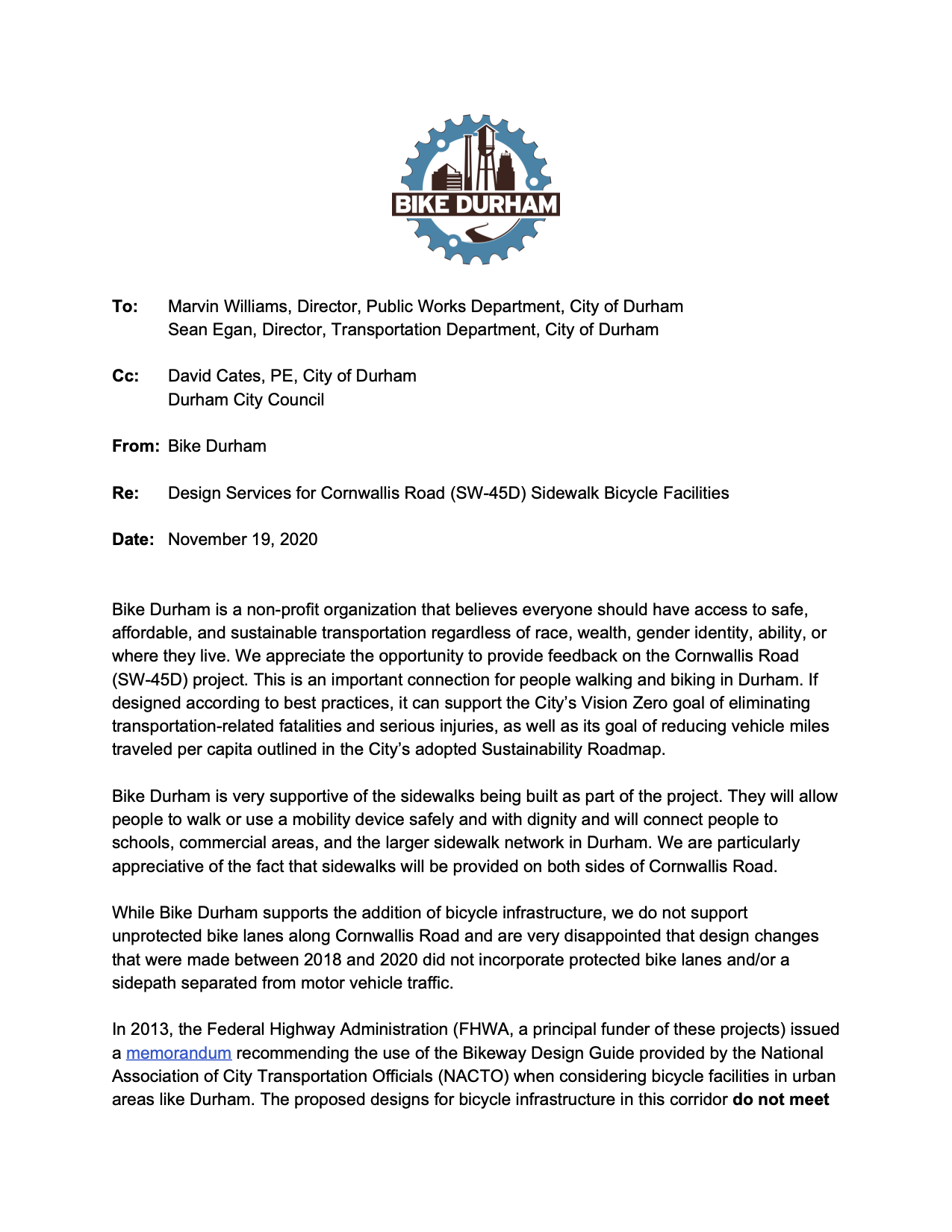
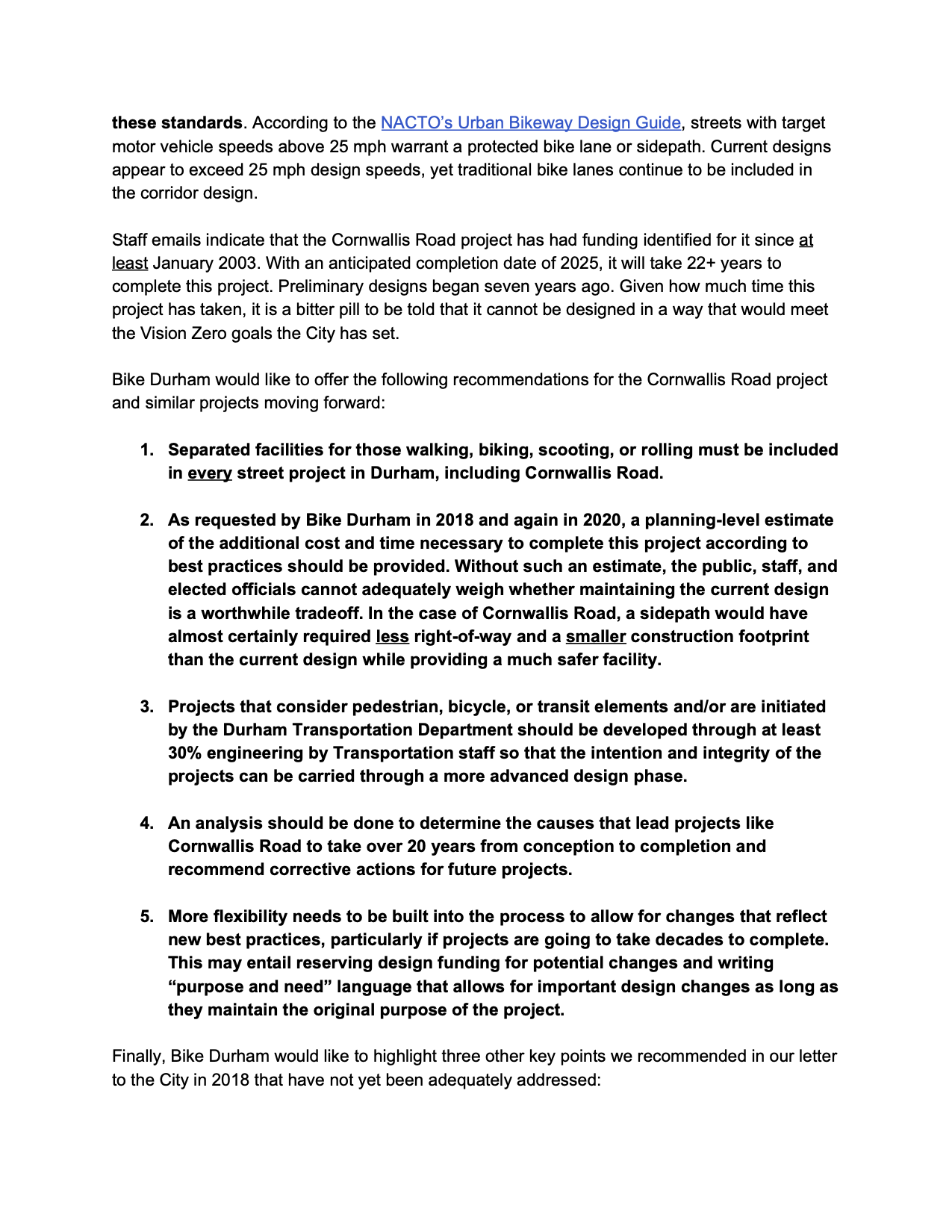
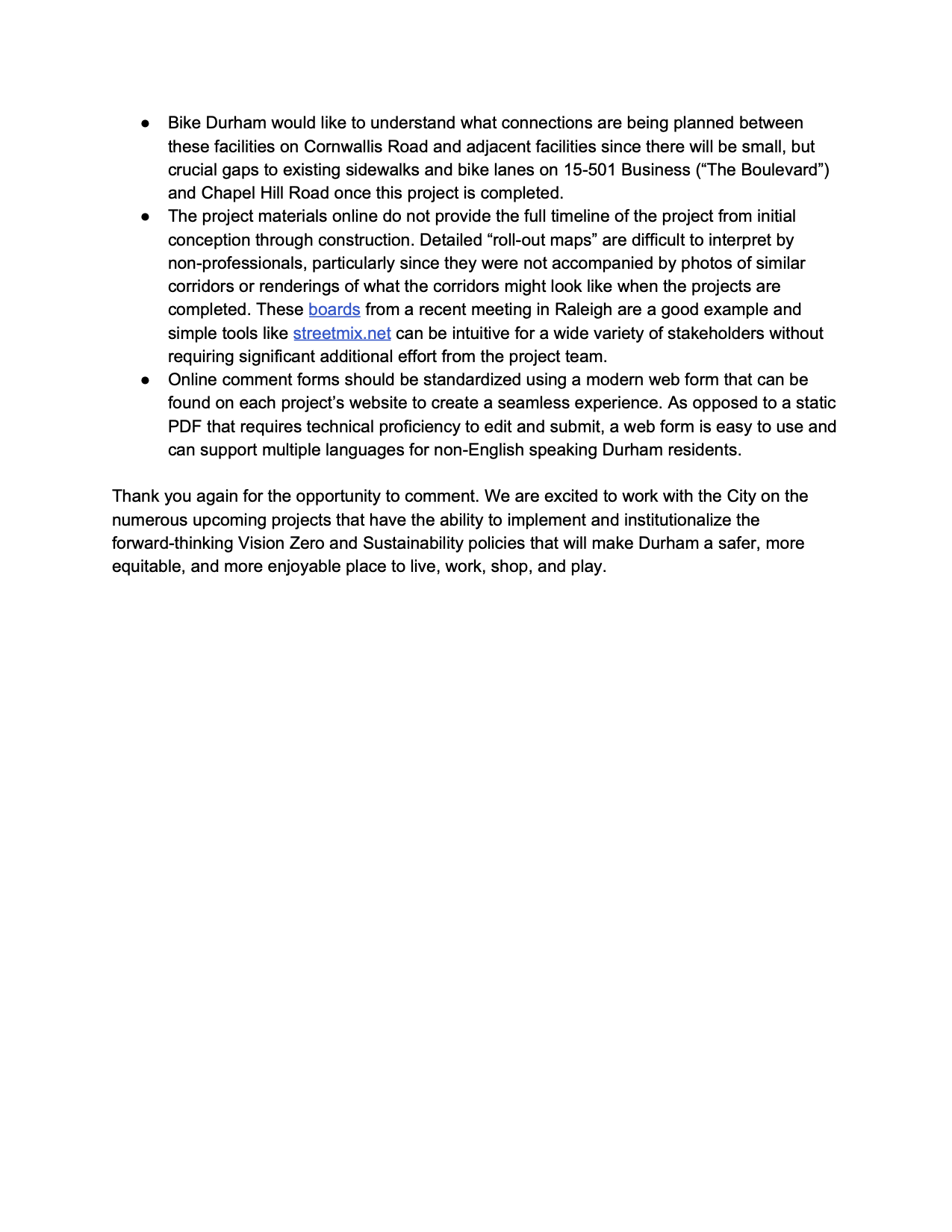
Halloween with Bike Durham
This Halloween, Bike Durham organized the first-ever Ghost Stories Tour, a group ride in which we visited seven haunted locations around Durham. These included Duke’s Parapsychology Lab, where we learned of the poltergeist that haunted Carl Jung, the old Durham County Jail, where the ghost of a drowned boy lingers, and the North Carolina School of Science and Math (formerly Watts Hospital), where a security guard spotted the ghost of a murdered nurse one rainy evening. This ride was special in many ways, not the least of which is that it was our first group ride since the pandemic began.
After lengthy conversations about how to make this event as safe as possible in the midst of a pandemic, the event organizers decided to cap each ride at 15 participants and require masks and social distancing while on the ride. Although we were taking precautions, we wondered whether anyone would show up given the legitimate concerns about the spread of covid.
We were thrilled when we discovered that each ride had reached the cap, although we were disappointed that we couldn’t include everyone who wanted to go on the ride. Ride leaders Danielle King, Shaun King, Alison Klein, Seth LeJacq, Marc Maximov, and John Tallmadge led the groups on a 10-mile trip around the city at dusk: one group on Saturday, October 24, and two groups on Saturday, October 31. We gave away candy and lights, and we were delighted at the costumes that bikers wore: a clown and a haunting, two llamas, Amelia Earhart, and a witch, among others.
We set up the route in Ride with GPS, a route planning app that allows planners to add stops, information, and even photos (Bike Durham membership comes with a free account on Ride with GPS). We were therefore able to include archival pictures for each stop, as well as additional information about the story of that location, which riders could look at when we reached a stop or browse later at their convenience.
Last year, we created a pumpkin-protected bike lane along one block of the route, Broad Street between Perry and Markham, it was featured in Streetsblog USA and we made a short video about it. We recreated it again for 2020 with dozens of carved pumpkins standing in the gap between riders and vehicles, drawing attention to the need for physical barriers on bike lanes throughout the city in order to protect bikers.
At each stop, we played snippets of horror movie music, and participants guessed which movie the piece came from; winners were rewarded with Reese’s peanut butter cups. Darkness fell as we completed the route, which made the stop at the old railroad tracks on Washington even spookier, and the giant lawn decorations in the shape of Beetlejuice sandworms even more impressive. At the end of the October 31 ride, bikers stood and chatted in CCB Plaza for 20 minutes, and some new friends even went off to an art exhibit together.
We hope to make this ride an annual tradition! We want to thank librarians Valerie Gillespie, Kelley Lawton, and Elizabeth Shulman for their help in uncovering these ghost stories; Open Durham for their excellent archival photographs and historical information; Kyle Sullivan for sharing his professional-level photographs with us; and everyone who participated. We hope you had as much fun on the ride as we had planning it.
Switching Gears during COVID-19
Author Dr. Naima Stennett, Board-Certified Family medicine physician and Sports Medicine Fellow
We have a saying in medicine, “Exercise is medicine.” During this pandemic one way we can be healthy is to re-visit an old skill or try something new. After all we know once you learn how to ride a bike you never forget. There are multiple benefits of riding a bike. These can be remembered with the mnemonic C.Y.C.L.E
C: Cardiovascular health and other chronic conditions: cardiovascular health include stroke, high blood pressure and heart attack. Regular cycling improves circulation as week as heart and lung function. These benefits your risk of cardiovascular diseases. Regular cycling has the added benefit of glucose control and reducing risk of diabetes.
Y: Your weight – Cycling can help burn fat and paired with a healthy eating plan can boost your metabolism helping you lose weight.
C: Clear mind: Cycling like other aerobic exercise stimulates the release of endorphins, (the feel good hormones) this results in a feeling of well-being and promotes positive emotions such as happiness.
L: Lean muscle and strong bones: Resistance activities such as pedaling up the sloping trails help to build and strengthen muscles as well as increase bone density.
E: Easy on your joints: Cycling is a low impact sport. Due to the minimal stress on the joints Individuals who suffer from joint pain can easily participate.
Getting Started with the basics
Helmet: With safety being the priority it is important to purchase a helmet that fits appropriately.
A bike that fits: It is important to connect with a local Bike shop that will help you pick the right bike for your height. They will help match you with a bike for the type of terrain well as customized fitting to make you’re ride enjoyable.
Saddle: It is important to know that this just as important as getting fitted for the right pair of sneakers. One of the main purposes of the saddle is to provide support and prevent increase pressure to the perineum. It is important to have the right saddle as this can reduce numbness and tingling in the legs due to compression of nerves and arteries that supply the lower body.
Cycling gear: Bike shorts are engineered to have thick padding to reduce chafing and cushioning while you ride. Various cycle jersey exist that help both in warm and cool temperature. They also have reflective designs so that both motorist and another cyclist can see you.
Water bottle rack: It is important to stay hydrated during activities especially If you plan to do more than 1 hours of cycling. Hydrated before, during, and after your ride.
Other tips: Find a local bike club that can help you stay motivated to keep pedaling. There are many bike lanes and trails in the Raleigh-Durham area including the American Tobacco Trail. New riders should avoid riding on the street especially if they do not have bike lanes. Lastly, do not forget your sunscreen and sunglasses
Happy Cycling
No content in this article should be used as a substitute for direct medical advice from your doctor or other qualified clinician.
Bike Durham Webinar: Working with State and Local DOTs for Safe & Healthy Streets
On Wednesday, September 24, 2020, Bike Durham held a two-part webinar on the challenging conditions of many Durham streets, and on how design firms are working with state and local Departments of Transportation to make streets more accessible to all users. The webinar, sponsored by HDR, Inc, was moderated by Bike Durham director John Tallmadge.
It began with a discussion by Bonita Green, president of the Merrick-Moore community club, about unsafe road conditions in that neighborhood. Next, Oxford Manor community leader Tammy Ferrell spoke on the streets in her area.
Then Patrick McDonough, AICP; Rick Plenge, PE, PTOE; and Michelle Podeszwa, PE, all of HDR, Inc., shared their experiences working with state and local transportation departments to develop street designs that are safer for people walking and biking.
The webinar ended with a brief Q&A. Text from the chat is as follows:
From Charlie Reece: Hi everybody, this is Charlie Reece from the Durham City Council. Great to see y’all, looking forward to this webinar.
From Zack Hawkins: I appreciate this webinar, as well. Zack Hawkins, NC House District 31. Look forward to getting the recording to share out on my page, if permissible.
From SpiritHouse NC: I love this kind of background.
From Erik Landfried (he/him), Bike Durham: It's frightening to even drive on Cheek Road.
From SpiritHouse NC: It is frightening.
From SpiritHouse NC: There is a city process for speed bumps but it is a very difficult process.
From Bonita Green: Merrick Moore has worked with DPD and DSO to do speed traps. This works for a while but eventually the speeding starts again.
From Kevin Young: Yeah, I've tried to ride on Old Oxford. It's nuts.
From Kevin Young: Thank you Tammy.
From Molly De Marco (she/her): Thanks Tammy!
From Zack Hawkins: Thanks for sharing.
From Constance: There are huge traffic issues on Belvin Ave at Danube. Potholes, narrow streets. Also at East Club to Glenbrook Dr.
From Kevin Young: Agreed Constance, no space on East Club, it's hairy.
From Kevin Young: May I ask please, are there any DOT people in this meeting/presentation?
From Mary-Jo Gellenbeck: Thank you promoting low-cost implementations to generate faster improvements.
From John Tallmadge, he/him, Bike Durham: I don’t think so, Kevin. Richard Hancock from Division 5 had registered, but it doesn’t appear that he has been able to join.
From Kevin Young: Thanks John.
From John Tallmadge, he/him, Bike Durham: North Roxboro Street is a 4 lane road like that.
From Kevin Young: John, it is, but it's not nearly as wide as this image.
From Kevin Young: This is cool, looks cool in the illustrations. John, let's do this on Roxboro. And Tammy, on old Oxford.
From Matthew Clark (he/him): My question is for John or folks with the City. Durham’s transit tax brings in millions of dollars every year. Could that revenue be used to purchase streets from NCDOT if the purchase is part of a larger plan for a safe, reliable, and sustainable transit and mobility system in Durham? And what are the pros and cons of doing something like that?
From Bonita Green: What low cost suggestions do you have for two-lane rural roads with no shoulder?
From Constance: How did these projects affect neighborhoods as far as destruction, especially lower-income and neighborhoods with limited investments?
From Charlie Reece: Mr. Clark, thanks for that question. That’s certainly possible, but there are lots of competing needs that need to be addressed by the Durham transit tax (including robust funding for our bus system). But I’d also point out that the transit tax is collected by Durham County, not the city of Durham, and our friends at the county commission determine the spending priorities for those funds.
From Charlie Reece: I need to step away but I will watch this Q&A section later once the recording is posted. Many thanks to everyone for a great event!
From Bonita Green: The lanes are very narrow. Resurfacing is the only improvement that has been done.
From Zack Hawkins: Thanks everyone. Look forward to being in touch. Good job Bike Durham and HDR.
Bike Durham Launches Transit Equity Campaign
On September 1, 2020, Bike Durham launched the Transit Equity Campaign in partnership with four other Durham nonprofit organizations: the Coalition for Affordable Housing and Transit, the Durham Committee on the Affairs of Black People, Durham Congregations in Action, and the People’s Alliance. The following press release lays out the campaign’s vision and the urgency of its mission. For more information about the campaign, including how to get involved, visit bikedurham.org/transit.




Our Comments on the 2050 MTP Draft Goals and Objectives
CALL TO ACTION
The Durham-Chapel Hill-Carrboro Metropolitan Planning Organization (DCHC-MPO) is responsible for transportation planning for Durham and the western part of the Research Triangle area. On August 12, they held a public meeting to discuss their 2050 Metropolitan Transportation Plan (MTP) Goals and Objectives. This long-range transportation plan is updated every four years and guides transportation investments in the region.
While we agree with the inclusion of goals and objectives that go beyond the traditional measures of traffic speed and congestion delay we don’t believe that they are responsive to the values of our community. By 2050, we want to see zero disparity of access based on race and income, zero carbon emissions, and zero deaths and serious injuries on our streets and highways.
Please contact your elected officials on the MPO Board this week and ask them to direct staff to rewrite the goals to more clearly communicate the direction we want to go, and to rewrite the objectives to establish measurable outcomes for 2050 and interim years that will get us to zero disparity, zero emissions, and zero deaths. Ask them to vote against these goals and objectives unless they are changed.
You can view Bike Durham’s full recommendations on each of the Goals and their objectives below:
Goal: Protect the Human and Natural Environment and Minimize Climate Change
Objectives: Reduce mobile source emissions, GHG, and energy consumption; Reduce negative impacts on natural and cultural environment; Connect transportation and land use
We agree that this is a very important goal, and appreciate that the staff has included it. We believe the first objective should be net-zero carbon emissions from the transportation sector by 2050. The second and third objectives are directionally fine, but they do not specify the conditions we aim to achieve by 2050.
Goal: Connect People and Places
Objectives: Connect people to jobs, education and other important destinations using all modes; Ensure transportation needs are met for all populations (especially the aging and youth, economically disadvantaged, mobility impaired, and minorities)
We agree that this is an important goal, but we do not believe the language is adequate. We urge rewriting the goal as “Connect all people and places without disparity.” We urge the objective to be “Achieve zero disparity of access to jobs, education, and other important destinations by race, income, or belonging to a marginalized group.”
Goal: Promote and Expand Multi-modal & Affordable Choices
Objectives: Enhance transit services, amenities and facilities; Improve bicycle and pedestrian facilities; Increase utilization of affordable non-auto travel modes
While we support these strategies and tactics in achieving the goals of zero carbon emissions, zero disparity of access, and zero deaths on our streets and highways, the only goal defined here is affordability. We urge rewriting the goal as “Ensure that all have affordable access to the transportation system.” We ask that the objectives include: “No one should pay more than 40% of their income for housing plus transportation by 2050.” It may be valuable to establish objectives around the percentage of trips that use sustainable modes of transportation, but we would recommend that be established under the first goal, supporting the objective of zero carbon emissions, paired with an objective regarding the percentages of the motorized fleets that are electric.
Goal: Manage Congestion & System Reliability
Objectives: Allow people and goods to move with greater reliability; Promote Travel Demand Management (TDM, such as carpool, vanpool, telecommuting and park-and-ride); Enhance Intelligent Transportation Systems (ITS, such as ramp metering, dynamic signal phasing and vehicle detection systems)
We agree that system reliability is an important goal. By that, we mean that connections are available when people need them, and that travel times are predictable. Measures of congestion are not as important as measures of travel time predictability, and travel times should be comparable for all system users. "Objectives 2 and 3" are strategies, not objectives.
Goal: Improve Infrastructure Condition and Resilience
Objectives: Increase proportion of highways and highway assets in 'Good' condition; Maintain transit vehicles, facilities and amenities in the best operating condition; Improve the condition of bicycle and pedestrian facilities and amenities; Promote resilience planning and practices; Support autonomous, connected, and electric vehicles
This is a well-defined goal and set of objectives—except for the last one. The last objective seems to be a strategy, and doesn’t have a clear connection to the goal. Also, “improving conditions” should not be equated with expanding capacity. There is a long tradition defining any transportation project as an “improvement” (i.e., Transportation Improvement Program).
Goal: Ensure Equity and Participation
Objectives: Ensure that transportation investments do not disrupt communities; Promote equitable public participation among all communities
We agree with the goal; however, the first objective does not acknowledge that the existing transportation system has placed disproportionate burdens on low-income communities, especially Black communities, and on individuals without regular access to a car. One objective should be a transportation system with zero disparities of access based on race, wealth, income, gender identity, age, or ability. We urge rewriting the second objective to read, “Ensure equitable public participation among all communities: geographic, racial, age, income, gender, and ability.”
Goal: Promote Safety and Health
Objectives: Increase safety of travelers and residents; Promote public health through transportation choices
This is an essential goal. Objective 1 should be stated as zero deaths or serious injuries on our streets and highways by 2050. Objective 2 should be measurable, such as “All residents will have safe access to active transportation choices by 2050.” Interim targets should also be established.
Goal: Stimulate Economic Vitality
Objectives: Improve freight movement; Coordinate land use and transportation; Target funding to the most cost-effective solutions; Improve project delivery for all modes
While the goal seems laudable, it does not indicate for whom. When we don't indicate for whom we are stimulating economic vitality, there is usually a group left behind, and that group is usually those who are Black or brown, and at the lowest end of our income and wealth scales. If our transportation system is to become equitable, it needs to stimulate economic vitality for all socio-economic groups, with objectives, and ways to measure progress, set toward that goal. We recommend a replacement goal of “Enhance inclusive local and regional economic opportunity.”
Second, "improve freight movement" is ambiguous. Does this mean shorter freight travel times? Or greater predictability of travel times? If a goal suggests the direction we're going, an objective should communicate where we want to end up. Improving freight movement doesn't do that. Neither does the fourth objective. The third objective is important, but it isn’t specific to this goal. We want cost-effective solutions that achieve multiple goals.
We recommend the following objectives: Maximize local-hire opportunities in construction, operation, and maintenance projects; prioritize pedestrian and bicycle access to local businesses over automobile access and parking; promote transportation-related businesses in ways that help ownership reflect the demographics of the regional population by race and gender; and ensure projects that benefit the local community without displacing residents.
Bike Durham's Letter to the City on the Move Durham Transportation Study
In late June 2020, the City solicited feedback on its Move Durham Transportation Study. The public was invited to post comments on the pdf in the above link through July 24.
While the study contains many admirable improvements to the downtown Durham streetscape, we feel it doesn’t go far enough in envisioning a more walkable, bikeable, transit-friendly city. On July 28, Bike Durham sent a letter to the Transportation Department summarizing our response. The text of the letter is below.











